CalCOFI Conference 2022
Innovative techniques and novel applications of time series data to marine resource management
December 5th - 7th, 2022
Location: Southwest Fisheries Science Center
La Jolla, CA
in person with a hybrid option available
Hosted By:
Scripps Institution of Oceanography
In Association With:
California Department of Fish and Wildlife
Southwest Fisheries Science Center
For conference inquiries,
please email Erin Satterthwaite, CalCOFI Coordinator
Overview
Please join us for this year’s CalCOFI Conference 2022, Innovative techniques and novel applications of time series data to marine resource management, which will be held at Southwest Fisheries Science Center in San Diego, CA, from December 5th – 7th, 2022. The conference will happen in-person with a remote option and will consist of keynotes, panels, contributed talks, posters, and workshops related to innovations in data collection, analysis, and applications of time series data, as well as understanding the State of the California Current.
Conference Description
Methodological innovations in the collection, use, and application of ocean ecosystem data are needed to meet the challenge of evaluating the current state and predicting future conditions of rapidly changing marine ecosystems. The goal of the CalCOFI Conference 2022, Innovative techniques and novel applications of time series data to marine resource management, is to explore and refine data collection, processing, techniques, analysis, and serving tools used to support the management of marine resources, including fisheries, energy, aquaculture, sanctuaries, cultural heritage, and climate mitigation and adaptation.
We invite speakers to explore ways to apply non-traditional data to fisheries assessments, renewable energy & aquaculture siting, cultural heritage, and other marine management applications. This could include utilizing existing data in new and emerging spatiotemporal statistical modeling methods, including predictive ecological modeling. We also invite presenters to share new technologies that could augment the utility of existing long-term sampling techniques, such as through innovations in sampling platforms and methods (e.g., uncrewed systems, aerosol sampling, participatory monitoring); biodiversity sensor technologies (e.g., Imaging FlowCytobot, CytoBuoy, Video Plankton Recorder, and passive/active acoustic sensors); and novel forms of data collection (e.g, environmental DNA, chemical tracers, and larval fish otolith analysis).
In addition, we welcome submissions that provide insight into the structure, functioning, and dynamics of the California Current Ecosystem and other Eastern Boundary Upwelling Systems, including the biophysical and human dimensions.
Conference Agenda
Innovative techniques and novel applications of time series data to marine resource management
December 4th, 2022
Arrival
7:00pm - 8:30pm - Pre-conference casual meetup at La Jolla Shores Hotel Restaurant (No Host)
December 5th, 2022
State of the California Current Ecosystem
8:30am - 9:00am - Welcome Ceremony & Opening of the Conference
Noelle Bowlin, NOAA Southwest Fisheries Science Center (SWFSC)
Brice Semmens, Scripps Institution of Oceanography, UCSD
Margaret Leinen, Scripps Institution of Oceanography, UCSD
Moderator: Brice Semmens, Scripps Institution of Oceanography, UCSD
9:00am - 10:00am - State of the California Current Ecosystem & State of the Fisheries Report
Andrew Thompson, NOAA Southwest Fisheries Science Center (SWFSC)
Rasmus Swalethorp, Scripps Institution of Oceanography, UCSD
Julia Coates, California Department of Fish & Wildlife (CDFW)
Moderator: Ed Weber, NOAA Southwest Fisheries Science Center (SWFSC)
10:00am – 10:30am - Morning Coffee/Tea Break
10:30am - 11:30am - Ocean Observations from the Field: Panel & Discussion
Joe Cacciola, Captain Sea Star, Oceanside, CA
Abreanna Gomes, Environmental Specialist II, Kashia Band of Pomo Indians
Renae Logston, CalCOFI Technician, Scripps Institution of Oceanography, UCSD
Shane Volberding, owner of Shane’s Seafood & Mackerel Fisherman
11:30am - 12:00pm - Lunch
**on-site lunch will be provided**
12:00pm - 1:00pm - Pier/Pelagic Invertebrate Collection (PIC) Tour (meet outside of the Pacific Room at the <a title="southwest fisheries science center" <a="<a title="southwest fisheries science center"Southwest Fisheries Science Center)
For the tour we will meet outside the Pacific Room @ 12:00pm and then we will split in half & walk to the Pier or the Pelagic Invertebrate Collection (PIC) which is located in Vaughan Hall, Room 125
1:00pm - 3:00pm - Contributed talks: Part I
Moderator: Briana Brady, California Department of Fish and Wildlife (CDFW)
Brian Dresser, Tetra Tech
Offshore wind development is gaining momentum in the United States. Trenching for the first cable for a commercial scale offshore wind farm began in late October 2022, with turbine construction and operations soon to follow. Impacts to fisheries and protected marine species remain some of the largest concerns for development, and one of the limiting factors is the apparent lack of fine scale fisheries and biological data. Multiple federal and state agencies have attempted to gather fisheries data and provide user-friendly interfaces such as mapping portals and summary documents. While these can be useful, feedback from fishers indicates that data sources such as VMS and AIS don’t accurately portray where and when they fish, and feedback from other stakeholders has highlighted that the biological data portrayed is often outdated. Offshore wind on the west coast is in its infancy, but the PACW-1 leases are taking place right now and designing and planning offshore wind farms at Morro Bay and Humboldt will soon follow. How do we best site and design offshore wind farms to allow for continued use for fishers and other ocean users? Is micrositing turbines compatible with floating offshore wind installations? We explore these questions along with the available data and data gaps, and make recommendations for the applications of existing west coast data based on lessons learned from the U.S. east coast and Europe.
Toby Auth, Pacific States Marine Fisheries Commission
E.J. Dick, Fisheries Ecology Division, Southwest Fisheries Science Center, National Marine Fisheries Service
Melissa Haltuch, Fisheries Research, Analysis and Monitoring Division, Northwest Fisheries Science Center, National Marine Fisheries Service
Mary Hunsicker, Fish Ecology Division, Northwest Fisheries Science Center, National Marine Fisheries Service
Tanya Rogers, Fisheries Ecology Division, Southwest Fisheries Science Center, National Marine Fisheries Service
Keith Sakuma, Fisheries Ecology Division, Southwest Fisheries Science Center, National Marine Fisheries Service
Jarrod Santora, Fisheries Ecology Division, Southwest Fisheries Science Center, National Marine Fisheries Service
Nick Tolimieri, Fish Ecology Division, Northwest Fisheries Science Center, National Marine Fisheries Service
The National Marine Fisheries Service (NMFS) has conducted an annual midwater trawl survey for pelagic young-of-the-year (YOY) rockfish in the California Current for the last 40 years to inform recruitment estimates in stock assessments. While the initial survey was limited to central California waters, the survey expanded geographically in the early 2000s due to the failure to detect a very strong 1999-year class. Investigations indicate that survey recruitment indices are more consistent with stock assessment results when informed by the larger survey area, despite the observation that YOY catch rates generally co-vary among California Current regions. However, these investigations indicate that covariation between survey recruitment indices and estimates of year class strength from stock assessments are not always strong. This result exemplifies the challenges faced in informing stock assessments with either, or both, YOY survey indices and environmental indicators of year class strength. Despite these challenges, YOY survey indices may improve near-term estimates of year class strength in rockfish stock assessments, and provide more realistic population projections for management models. We discuss the survey history, emphasizing recent coast-wide pre-recruit data, and our efforts to better quantify and resolve the challenges associated with including YOY survey indices into the stock assessment models that inform management.
Jerome Guiet, Atmospheric & Oceanic Sciences, University of California, Los Angeles
Daniele Bianchi, Atmospheric & Oceanic Sciences, University of California, Los Angeles
Kaushik Srinivasan, Atmospheric & Oceanic Sciences, University of California, Los Angeles
Carrie C. Wall,Cooperative Institute for Research in Environmental Sciences, University of Colorado, Boulder
Mid-trophic level (MTL) organisms are abundant in the California Current Ecosystem (CCE) and play an essential role in the flow of biomass from primary producers to top predators. Yet, their distribution and variability are not fully understood. This lack of understanding emerges from both the complex interaction of MTLs with their environment and the difficulty of sampling these organisms in situ. To close this gap, we use 12 years of acoustic data in the CCE to describe the spatio-temporal dynamics of MTLs. Observations at 38 and 120kHz, during day and night, on multiple depth strata (from 15 to 515m), show consistent seasonal and latitudinal shifts in the acoustic backscatter of epipelagic and mesopelagic organisms. In the Southern California Bight, coastal pulses of epipelagic backscatter begin near the coast, spread offshore, and reach a minimum in winter. This succession also occurs for mesopelagic backscatter, although with a multi-month delay. Along the coast, during peak upwelling, epipelagic backscatter shows two regional maxima around 35N and 45N, whereas mesopelagic backscatter remains more uniform with latitude. While acoustic backscatter reflects a combination of community composition, organism abundance and acoustic properties, these large-scale variations shed new light on the regional variability of MTLs and its drivers. We further train a machine learning algorithm with co-located remote sensing data and reanalysis products to fill the gaps in the acoustic observations, providing a broader view of backscatter dynamics in the CCE.
Juan P. Zwolinski, NOAA Southwest Fisheries Science Center & UCSC
David A. Demer, NOAA Southwest Fisheries Science Center
The oceanographic environment has been proposed as the main driver of boom and boost events in small pelagic species. However, for the Pacific sardine off the West Coast of the US, neither the mechanisms driving their dynamics nor the environmental proxies for their productivity are fully understood. For example, sardine’s resurgence in the 1990s lagged the environmental regime-shift by approximately ten years, suggesting other mechanisms may be modulating the stock’s productivity. One hypothesis proposes that the schooling nature of small pelagic fishes forces individuals of a depleted stock to join schools of other more abundant fishes. This “school trap” effect results in the depleted species compromising its own habits in exchange for the protection that the mixed-species schools offer. In this presentation, we show that the school trap hypothesis predicts virtually every distributional pattern observed from the currently depleted stock of Pacific Sardine, including interrupted migrations and shifts in their environmental preferences. The changes in behavior promoted by sardine schooling predominantly with the far more abundant Jack Mackerel may explain why the stock failed to respond positively to favorable oceanographic conditions that have occurred off the West Coast in the last five years.
Robert Lampe, Scripps Institution of Oceanography, J. Craig Venter Institute
Ariel Rabines, Scripps Institution of Oceanography, J. Craig Venter Institute
Elizabeth Venrick, Scripps Institution of Oceanography
Ralf Goericke, Scripps Institution of Oceanography
Anne Schulberg, Scripps Institution of Oceanography, J. Craig Venter Institute
Pratap Venepally, J. Craig Venter Institute
Hong Zheng, J. Craig Venter Institute
Lisa Zeigler, Scripps Institution of Oceanography, J. Craig Venter Institute
Kelly Goodwin, National Oceanic Atmospheric Administration
Andrew Allen, Scripps Institution of Oceanography, J. Craig Venter Institute
Coastal upwelling regions such as the California Current Ecosystem are among the most biologically productive regions in the ocean: a phenomenon attributed to the frequent delivery of cold, nutrient-rich water that fuels diatom-dominated phytoplankton blooms. Consequently, diatoms drive biogeochemical cycling and support the highly productive fisheries in these upwelling ecosystems. Here we examine pelagic diatom abundances and diversity in the California Current Ecosystem via seven years of CalCOFI surveys. Nearly 1000 DNA samples were used to sequence 18S-V4 and 18S-V9 marker genes with additional samples for gene expression and microscopic cell counts. Seasonality associated with upwelling conditions was found to be a distinct and significant driver of both abundances and diversity. Concurrently, gene expression associated with growth, photosynthesis, and reproduction were also highly correlated with increased abundance and diversity. Overall, the community is dominated by the large chain-forming genera Chaetoceros, Thalassiosira, and Pseudo-nitzschia although some of these dominant taxa are dispersal limited indicating rapid grazing or sinking in the nearshore environment. Differential abundance of specific ASVs highlights groups of diatoms that will potentially be selected for or against under potential future climate scenarios.
Stephanie Nehasil, UC San Diego
Emmanis Dorval, Lynker Tech, SWFSC
Carolyn M. Kurle, UC San Diego
Coastal pelagic species (CPS) support important commercial fisheries and are widely consumed by top marine predators in upwelling systems. Thus, they play significant roles in maintaining the livelihood of fishers and in transferring energy from lower to higher trophic levels. However, there is a paucity of basic information on the nutritional quality (i.e., energy density) of these key forage species in the California Current Ecosystem (CCE) and the factors affecting inter- and intraspecific variation in forage quality. Here, we aim to demonstrate the variability in nutritional quality for a complex of forage taxa that are ecologically and economically important within the CCE – Pacific sardine (Sardinops sagax), northern anchovy (Engraulis mordax), and market squid (Doryteuthis opalescens). Forage species were collected in Central and Southern California during 2014-2019 from NOAA CPS trawl and juvenile rockfish surveys, CDFW port sampling surveys, and a SWFSC sampling survey at the San Diego bait barge. Whole fish samples were analyzed for energy density (kJ g-1) using bomb calorimetry. Preliminary results suggest differences in forage quality by season, region, and size. Annual changes in quality were also investigated, particularly to determine potential disruptions in energy transfer during the 2014-2016 Marine Heatwave. Our preliminary findings suggest that top predators in the CCE have access to a range of low- to high-energy forage over space and time that most likely depends on CPS life history traits and species-specific energy storage strategies. Identifying trends in the energy density of forage taxa in the CCE may contribute to our understanding of energy requirements of top predators and the mechanisms linking environmental perturbations to predator demographics.
Noah Ben-Aderet, Ocean Protection Council
Steven Bograd, NOAA, SWFSC, ERD
Garfield Kwan, Scripps Institution of Oceanography
Jarrod Santora, SWFSC, FED
Isaac Schroeder, NOAA, SWFSC, ERD, UCSC, IMS,
Andrew Thompson, NOAA, SWFSC, FRD
Identifying factors that affect larval mortality is critical for understanding drivers of fish population dynamics. Although larval fish mortality is incredibly high, small changes in mortality rates can lead to large changes in recruitment. Recent studies suggest maternal provisioning can affect the susceptibility of larvae to starvation and predation. In this study, we measured otolith core width-at-hatch, a proxy for larval size-at-hatch, on 8 species of rockfish (Genus Sebastes) to examine the influence of initial larval size on larval growth and survival, and to understand how oceanographic conditions gestating females experience affect larval size (i.e., quality). Otolith core width-at-hatch was significantly positively related to recent growth rate (5/7 species with sufficient sample size) and survival (all species). This suggests individuals that are larger at hatch generally grow faster and are more likely to survive early life stages. Otolith core width-at-hatch positively relates to increasing percent of Pacific Subarctic Upper Water and is negatively related with Spiciness at the depths parents inhabited during the three months prior to larval collection. In addition, otolith core width-at-hatch was larger further from fishing ports possibly because these locations were historically less fished and contained more, older, larger females and/or had inherently better habitat quality than sites closer to shore. These results indicate that the habitat and environmental conditions female rockfish experience during gestation drives the size of the larvae they produce and impacts early growth and survival of rockfishes.
3:00pm - 3:30pm - Afternoon Coffee/Tea Break
3:30pm - 4:45pm - Contributed talks: Session II
Moderator: Trung Nguyen, California Department of Fish & Wildlife (CDFW)
Elan J. Portner, UC San Diego, Owyn Snodgrass, NOAA, SWFSC
Barbara Muhling, UC Santa Cruz, NOAA, SWFSC
Heidi Dewar, NOAA, SWFSC
Juvenile Albacore Tuna (Thunnus alalunga) are important predators in the California Current Large Marine Ecosystem (CCLME), where they support both commercial and recreational fisheries. Using a time series of Albacore diets off Northern California, Oregon, and Washington from 2009 to 2021, we investigate environmental drivers of diet variability and evaluate whether dietary differences affect intake of biomass or energy. Prey importance was quantified using three different mean proportional metrics: number, weight, and energy content of prey. Fishes were the most important prey group, and Northern Anchovy (Engraulis mordax) was the most important taxa, by all three metrics. In contrast, the relative importance of Euphausiids (Order: Euphausiidae) shifted from second to third and Pacific Saury (Cololabis saira) shifted from third to second in importance when measured using % weight or % energetic value versus % number. Using classification and regression tree (CART) analysis, Albacore diets characterized by % weight could be distinguished by sea surface temperature and the biologically effective upwelling transport index (BEUTI), both averaged over the first six months of the year of fish collection. Under all environmental conditions, the most important prey was either Northern Anchovy, Euphausiids, or Pacific Saury. The total number, weight, and energy content of prey per Albacore did not significantly differ across our time series, even when corrected for albacore size. Our findings indicate that Albacore diets have changed over time independent of the metric used and that diets have similar energetic values despite differences in prey composition. Further work will quantify the potential prey biomass removals in each mode and investigate the impact of diet on predator condition.
Kamran Walsh, SIO
Rasmus Swalethorp, SIO
Survival through the larval phase greatly affects the population dynamics of most fishes, and a major factor affecting larval growth and survival is the capacity to feed on preferred prey. Here, we examine the feeding ecology of Sebastes spp. larval rockfishes in the Southern California Bight (SCB) with respect to ontogeny, selectivity, and the influence of maternal investment. Rockfishes of the family Sebastidae comprise a highly diverse and abundant family of fishes in the SCB and are both economically and ecologically important. Larval rockfishes were collected from numerous CalCOFI stations throughout the SCB in fall 2020 and winter and spring 2021. Their stomach contents were extracted, identified, and enumerated. Maternal investment was estimated using the nuclear width of extracted otoliths, and growth rates were derived from standard length measurements and daily otolith rings. Larval diets were found to shift between succeeding developmental stages of copepod with changes in ontogeny. Selection towards Calanoid and Cyclopoid nauplii in preflexion larvae shifted to predominantly Calanoid copepodites in the postflexion stage. Positive relationships between otolith core width, length-at-age, and carbon biomass of gut contents suggest that increased growth rates facilitated by maternal investment allow larvae to capitalize more effectively on their preferred prey. These findings provide evidence of selective feeding throughout larval Sebastidae development, and support the notion that maternal investment is an important factor in determining larval growth and survival.
Emmanis Dorval, SWFSC
Pacific Sardine (Sardinops sagax) are an economically important forage fish in the eastern North Pacific Ocean that are managed under the Coastal Pelagic Species Fishery Management Plan of the Pacific Fishery Management Council. The stock assessments which generally occur annually incorporate fishery-dependent and fishery-independent age data generated by SWFSC, CDFW, and WDFW to inform the annual estimation of abundance. These federal and state agencies have worked closely with laboratories in Canada (DFO) and Mexico (CICIMAR-IPN) on ageing methodology to ensure consistency and maximize accuracy; however, the annuli in otoliths of Pacific Sardine have not been validated. Live Pacific Sardine (mostly age 0) were collected, marked with oxytetracycline (OTC), and raised in captivity at different temperatures (13℃, 15℃, 17℃, & 21℃) for up to one year. Otolith growth was higher for warmer temperatures. All of the individuals that were in captivity for one year (n = 21) deposited 2-3 increments distal to the OTC mark. This result serves to validate the assumption that annuli in otoliths are deposited annually in young Pacific Sardine (1-2 years old). This also supports the ageing methodology used for this species by all ageing laboratories in US, Mexico, and Canada, while providing new information to better develop studies on correlating Pacific Sardine growth to temporal variability in oceanic conditions.
John Field, Institute of Marine Sciences, UC Santa Cruz, SWFSC, NOAA
Sharon Melin, AFSC, NOAA
Jarrod A. Santora, SWFSC, NOAA
Brian K. Wells, Institute of Marine Sciences, UC Santa Cruz, SWFSC, NOAA
Isaac Kaplan, NWFSC, NOAA
Desiree Tommasi, Institute of Marine Sciences, UC Santa Cruz, SWFSC, NOAA
Barbara Muhling, Institute of Marine Sciences, UC Santa Cruz, SWFSC, NOAA
K. Alexandra Curtis, SWFSC, NOAA
California sea lions (Zalophus californianus) are emblematic and ecologically important predators that feed on a diversity of forage fish species. In southern California, sea lion diet reflects variations in the availability of some key forage species and changes in the overall species assemblages. However, such studies were limited to correlative analyses, preventing mechanistic quantification of the response of sea lion diet to changes in the availability of their prey. We use a Bayesian multispecies functional response (MFSR) model to link scat data of sea lions from different colonies to the relative abundance of prey in their respective foraging areas. Specifically, the MSFR model is fitted to 1990-2019 time-series of frequencies of occurrences of sardine (Sardinops sagax), anchovy (Engraulis mordax), market squid (Doryteuthis opalescens), Pacific hake (Merluccius productus) and rockfish species (Sebastes spp) in scats and regional abundance indices from an ecosystem assessment survey to estimate shape parameters of the Holling’s functional responses. These parameters notably characterize the feeding preference of sea lions for these major prey items. Our results notably highlight a high predilection of sea lions for high-energy content prey like anchovy, contrasting with a low affinity for species like squid, whose large consumption would be mainly driven by particularly high abundance in the foraging areas. Using the model in a predictive mode may allow us to estimate (i) the consumption of a given prey by sea lions when knowing its abundance and that of alternative prey and (ii) and the availability of a forage species in a given area when scat analyses are available. Thus, our approach has potential to strengthen the stock assessment of forage species in the California Current by providing more accurate natural mortality estimates, or extending abundance or recruitment time-series back in time when surveys were not available.
Emmanis Dorval, Lynker Tech, SWFSC, NOAA
Maya Philipp, UC San Diego
Market squid (Doryteuthis opalescens) is a key coastal pelagic species of the California Current Ecosystem and supports one of California’s most valuable fisheries. Yet, critical aspects of its dynamics and status remain unknown due to lack of adequate sampling coverage in space and time. Market squid are short-lived, with large population fluctuations and migrations that have been linked to seasonal and interannual temperature variation. California sea lions (Zalophus californianus) are important predators of market squid, which are more common in sea lion diet in the Southern California Bight (SCB) than any other prey species. California sea lions primarily consume large juvenile to adult size classes of market squid, with consumption shown to correlate to landings and to vary with El Niño Southern Oscillation (ENSO) index. We correlated quarterly indices of market squid consumption from the southern Channel Islands from 1999 to 2015 with spawning stock biomass (SSB) estimates of market squid for two management areas that overlap with known foraging ranges for these islands. We found strong correlation between market squid SSB and sea lion diet indices for the SCB as a whole, as well as evidence of resolution of subregional differences in SSB in diet indices from different islands, with promising results for refining parameters upon which egg escapement (an MSY proxy) is derived for this species. We also found strong temporal autocorrelation in quarterly squid consumption indices, with potential for better characterizing the spawner-recruit relationship, predicting market squid SSB three to six months in advance, and harnessing the power of a 40+-year quarterly time series of sea lion diet in the SCB to illuminate market squid population dynamics and environmental drivers. Sea lions prove to be effective samplers of market squid, with potential applications to monitoring this key species, better understanding its population dynamics, and improving stock assessment.
4:45pm - 5:00pm - Closing remarks
*No Recording Available
Ed Weber, NOAA Southwest Fisheries Science Center (SWFSC)
5:00pm - 8:30pm - Welcome Reception & California Sea Grant Early Career Ocean Professional Meet-up (<a title="Martine Johnson House" <a="<a title=" martin="" johnson="" house"Martin Johnson House)
**food, refreshments, & music by DJ Taters**
We strongly recommend that you wear warm attire as the evening reception will be outdoors, so will be cold and possibly windy
December 6th, 2022
CalCOFI Symposium
Sam McClatchie, FishOcean Enterprises Ltd
Brice Semmens, Scripps Institution of Oceanography, UCSD
Moderator: Brice Semmens, Scripps Institution of Oceanography, UCSD
9:00am - 10:00am - Keynotes: Innovations in Fisheries Management
Moderator: Brice Semmens, Scripps Institution of Oceanography, UCSD

Dr. Eric Ward, Statistician, NWFSC
Interest in ecological forecasting has rapidly increased over the last decade, with both data and methodologies evolving to meet the complex challenges of making predictions in a non-stationary world. Predicting future fish productivity or recruitment has been a focus of forecasting efforts in fisheries for the last century; this remains inherently difficult because recruitment time series are often short, they are produced from model estimates that are subject to error, mechanistic understanding of drivers is often limited. We assembled a dataset of 30 U.S. west coast groundfish stock assessments, and performed a short term (1–2 year) forecasting comparison across statistical models (parametric, non-parametric) and predictor variables to predict future recruitment deviations. Predictor variables included larval fish indices from CalCOFI and the Rockfish Recruitment and Ecosystem Assessment Survey, ROMS oceanographic model outputs, and derived ecosystem state indices (via dynamic factor analysis). Including a wide range of assessed species allows us to identify populations with skillful recruitment forecasts. Similarly, comparing statistical models or predictor variables is useful for identifying the most robust approaches for performing forecasts. Our results show that for 10 populations in our analysis, recruitment deviations can be forecast with some degree of skill (R2 > 0.7). We find that for the majority of these populations, larval fish indices from the CalCOFI survey offer the best predictive skill (lowest RMSE) – and in all cases, multivariate linear models outperformed more complicated approaches. Finally, we discuss caveats of this overall approach, as well as future research to better link these approaches with assessment tools.
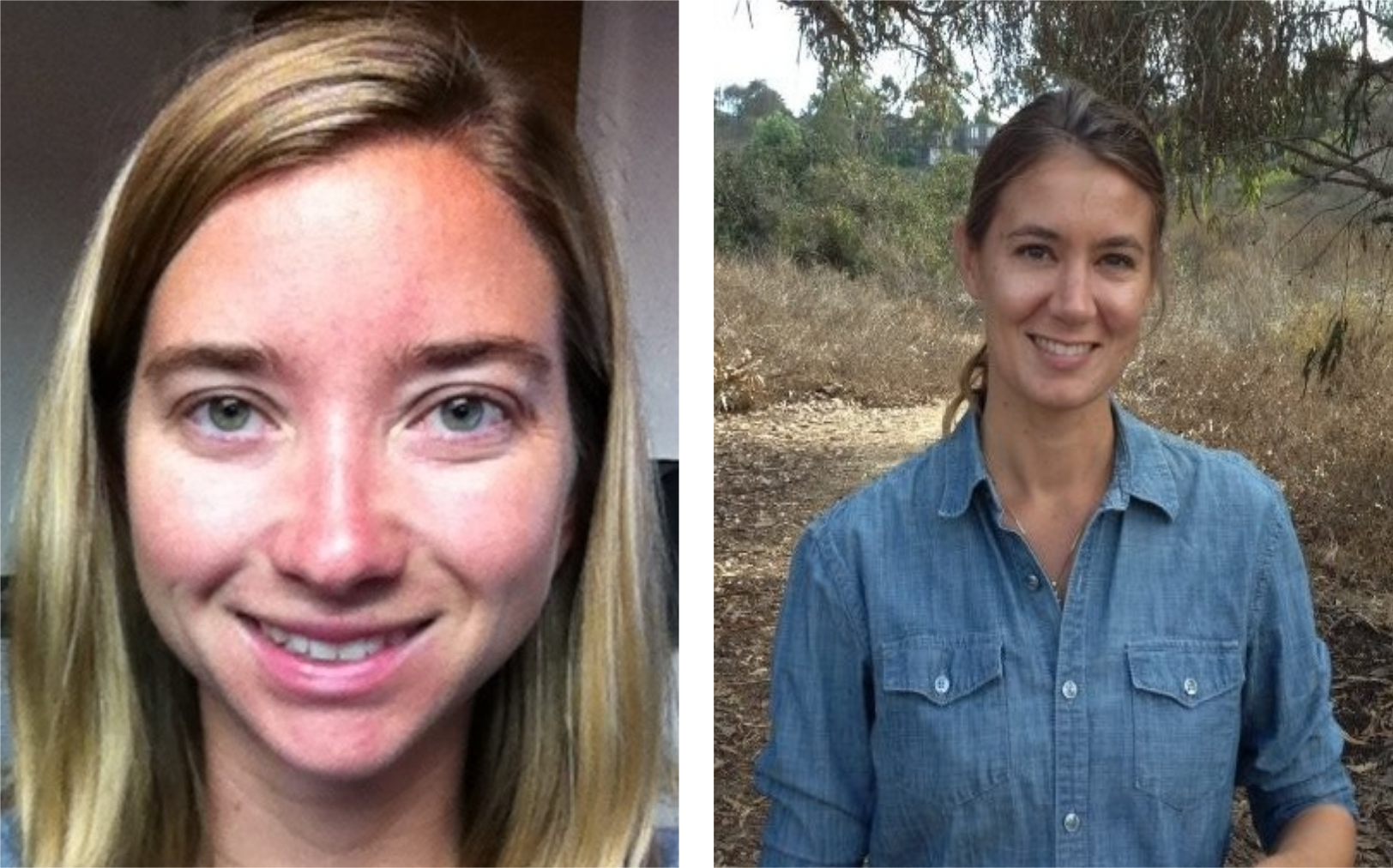
Katie Grady, Environmental Scientist, CDFW Julia Coates, Senior Environmental Scientist, CDFW
The market squid fishery is routinely the largest commercial fishery in California in terms of both landed volume and value. Market squid are terminal spawners, and like many short-lived species, exhibit rapid growth and population turnover, thus have highly variable abundance driven largely by environmental conditions. Empirical dynamic modeling (EDM) is a data-driven approach that is ideal for analysis of stocks like squid. EDM does not require model specification, assumptions, or prior knowledge of system dynamics. Instead, it is used to make predictions based on patterns in time series data. This allows for the full system complexity to emerge, unbiased by predetermined model equations. Fortunately, the California market squid fishery is relatively data rich with available information including landings, logbook effort data with high spatial specificity, detailed biological information from dockside sampling, and larval abundance surveys. In efforts to inform market squid fishery management and stakeholder deliberations, preliminary investigations using EDM explored (1) forecasts of landings informed by fishing effort and larval abundance at relevant temporal and geographic scales, (2) temperature data to evaluate climate impacts on squid, and (3) fishery effort scaling to compare the performance of management control rules. We obtain good prediction accuracy, particularly when using data post-2005 with the R2 of leave-one-out analyses yielding 0.60, 0.61, and 0.53 for northern, central, and southern fishery regions, respectively. We report the potential for CalCOFI data on larval abundance to improve accuracy. Results suggest that the current amount of fishing effort maximizes yield, particularly in the northern Channel Islands region. Temperature impacts yield and the effort level at which it is maximized. This indicates the ability of EDM to tease out complex spatial and temporal dynamics and highlight long-term survey information of greatest value.
10:00am - 10:30am - Morning Coffee/Tea Break
10:30am - 11:30am - Keynotes: Innovations in Water Quality & Ocean Observing
Moderator: Zachary Gold, NOAA, Pacific Marine Environmental Laboratory (PMEL)
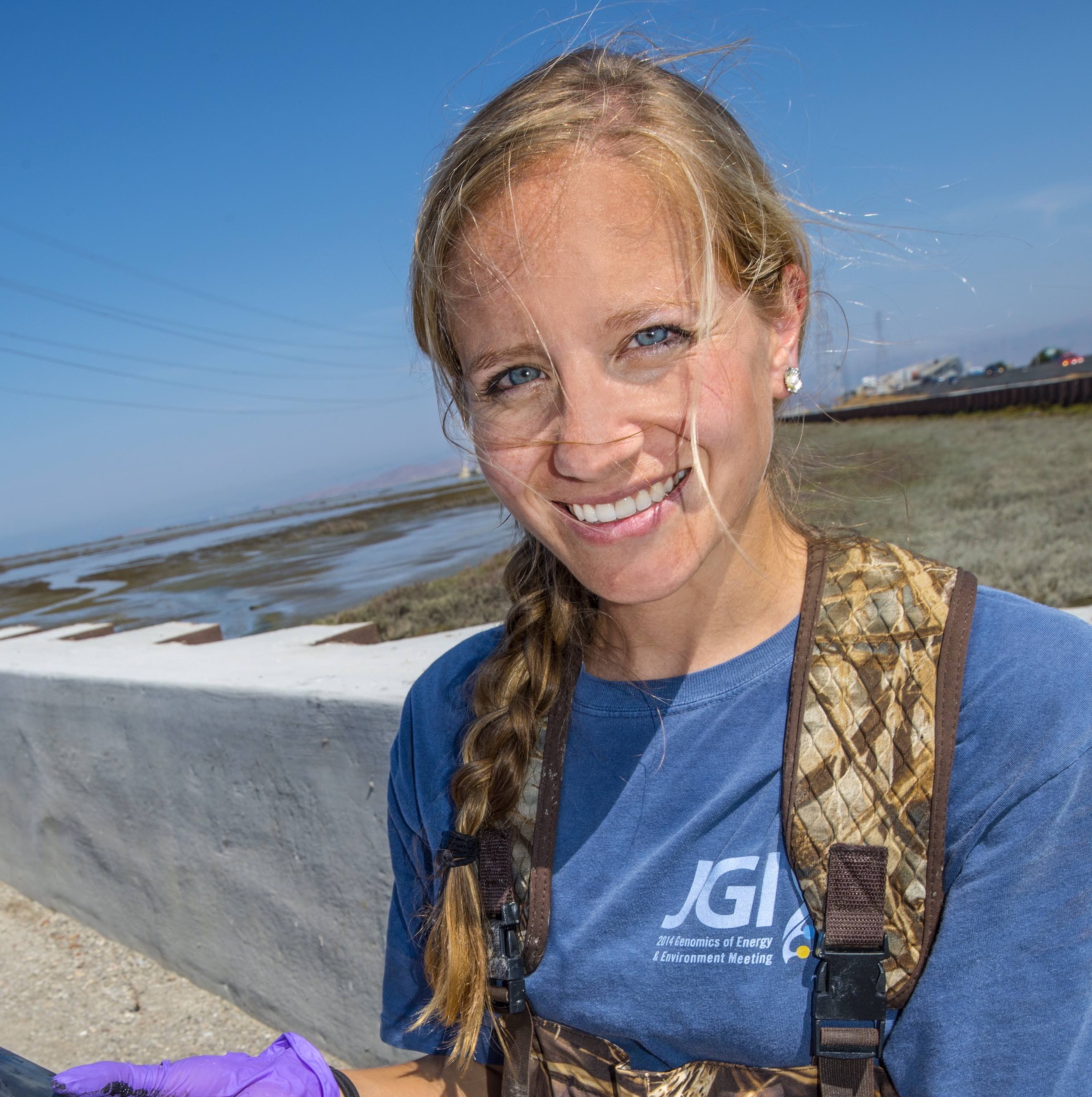
Dr. Susanna Theroux, Ecologist, Southern California Coastal Water Research Project (SCCWRP)
The use of environmental DNA (eDNA) for marine biological surveys has accelerated rapidly in the past decade. However, the adoption of eDNA methods for informing environmental management decision-making has lagged these scientific advances. Environmental managers are faced with adapting novel eDNA technologies to pre-existing monitoring programs, and in the process can encounter obstacles related to lack of DNA method standardization, lack of data reporting standards, and lack of lab accreditation procedures. In an effort to accelerate the adoption of eDNA methods for routine biomonitoring and bioassessment, workgroups such as the California Molecular Methods Workgroup, Better Biomolecular Ocean Practices (BeBOP) programme, and the Southern California Ocean Biomolecular Observing Network (SoCal-OBON) are working to harmonize eDNA sampling and analytical protocols and data reporting standards. In this presentation, we will review the efforts of these workgroups to bring together a diverse community of researchers and managers to enhance coordination across monitoring programs, perform intercalibration and optimization studies, and identify best practices and standardized protocols. We will also discuss outcomes of the 2022 National Marine eDNA Workshop that emphasized the need for a national strategy to eDNA method adoption and current efforts to scale international collaboration on eDNA method standardization.
 Megan Medina,
Megan Medina,Program Coordinator, Southern California Coastal Ocean Observing System (SCCOOS)
Mrs. Medina will discuss the need for a cohesive vision of ocean observing for understanding the ecosystem response to climate and ocean dynamics. The talk will focus on an approach to building capacity for downscaling biogeochemical and biological observing into the coastal zone.
11:30am - 12:00pm - Lunch
**on-site lunch will be provided**
For the tour we will meet outside the Pacific Room @ 12:00pm and then we will split in half & walk to the Pier or the Pelagic Invertebrate Collection (PIC) which is located in Vaughan Hall, Room 125
1:00pm - 2:45pm - Contributed talks: Session III
Moderator: Briana Brady, California Department of Fish & Wildlife (CDFW)
Rasmus Swalethorp, Scripps Institution of Oceanography, U. C. San Diego
Michelle Robidas, University of San Diego
Zack Gold, PEML, NOAA
Jerome Feitcher, U. C. Santa Cruz
Charles Hinchliffe, SWFSC, NOAA
Iain Suthers, University of New South Wales, Sydney
Fisheries scientists have been attempting to resolve the mechanisms governing massive fluctuations in year class strength (recruitment) of marine fishes for more than a century. Elucidating processes affecting recruitment have proven difficult, however, as the ocean is large and processes affecting larval fish survival can occur at microscopic scales. Fortunately, modern technologies are providing us with the potential to observe conditions at relevant scales and, if not solve, at least allow us to make significant progress towards understanding mechanisms driving recruitment dynamics. In the California Current Ecosystem (CCE), we are currently applying multiple novel approaches to hopefully elucidate recruitment dynamics of northern anchovy (Engraulis mordax). Anchovy abundance was high from the 1960s to the late 1980s, declined rapidly in the early 1990s, was low from 1991-2012 (with a brief resurgence in 2015), and was then extremely low from 2012-2014. However, a strong recruitment event in 2015 and subsequent years rendered adult anchovy abundance at near-record levels by 2021 and abundances remain very high in 2022. We are applying several lines of inquiry to discern the causes for these large fluctuations over the past 70 years. Compound Specific Stable Isotope Analysis showed that the trophic position of larval anchovy prey predicted anchovy spawning stock biomass two years later, and that a sudden, lasting transition to higher trophic level prey in 1989 predicted the 1990s population collapse. Analysis of larval anchovy condition and otoliths also indicated that maternal effects and ocean conditions impact the age and quality of ~ 3-5 week old larvae, and that recruitment positively correlated with larval condition between 2009 and 2019. To provide insight on the identity of anchovy larval prey during low and high recruitment years, we are conducting Environmental DNA (eDNA) analysis of water samples that is identifying phytoplankton and zooplankton assemblage composition from 2014-present. To better resolve the role of oceanography on anchovy recruitment, we are builidng Individual Based Models that will trace the transport and survival of larvae from 2000-2020. In addition, we are using larval age and size frequency data to estimate rates of Growth and Mortality to evaluate recruitment potential from 1951-present. This holistic approach will hopefully shed light on the age-old question of “what controls fish recruitment?”.
Zachary Gold, NOAA, Pacific Marine Environmental Laboratory (PMEL)
Brice Semmens, CalCOFI, SIO, UC San Dirgo
Noelle Bowlin, CalCOFI, SWFSC, NOAA
Susie Theroux, SCCWRP
Clarissa Anderson, SCCOOS, SIO, UC San Diego
Mark Ohman, CCE-LTER, SIO, UC San Diego
Stephanie Matthews, CCE-LTER, SIO, UC San Diego
Jeff Bowman, Scripps Ecological Observatory, SIO, UC San Diego
Katherine Barbeau, CCE-LTER, SIO, UC San Diego
Moira Decima, CCE-LTER, SIO, UC San Diego
Andrew Allen, CalCOFI NCOG, SIO, UC San Diego
Robert Lampe, CalCOFI NCOG, SIO, UC San Diego
Kelly Goodwin, NOAA, OAR
Nastasia Patin, NOAA, OAR
Bob Miller, SBC-MBON
Gabrielle Canonico, NOAA-MBON
The Southern California Ocean Biomolecular Observing Network’s (SoCal-OBON) is a cooperative of multiple southern California ocean observing programs and regional ocean stakeholders collectively promoting the integration and harmonization of molecular approaches in the Southern California regional biomonitoring efforts. The network’s primary objective is to provide an unprecedented resolution of key ecological indicators across space, time, and trophic levels relevant to marine management. To achieve this, the Network will integrate the suite of existing ocean observing platforms bridging nearshore and offshore biomonitoring efforts and apply standardized molecular approaches to best characterize biological communities and their response to environmental change across the Southern California Bight. This leveraged effort will combine physical and chemical measurements, advanced ocean imaging technologies, and molecular biomonitoring approaches to provide the ecological resolution needed to 1) understand the interplay of water quality and climate driven ocean acidification/hypoxia impacts on biological communities, 2) allow for the identification and forecasting of HABs, 3) better inform fisheries management through the identification of trophic and oceanographic drivers of assemblage dynamics, and 4) map spatio-temporal distributions of protected species. Key to the success of harmonizing ocean monitoring across ocean observing platforms is the standardization of molecular sampling efforts. To achieve these objectives this workshops will convene representatives from each Network partner; local, state, and federal management agencies; industry representatives; and academics to 1) identify operational, technical, and methodological gaps among current monitoring efforts, 2) identify key management questions and relevant biodiversity targets, 3) coordinate the design and validation of molecular assays for priority biological and chemical targets, and 4) plan and coordinate leveraged studies to compare current sampling practices and identify key areas of disagreement across platform-specific sampling methods. We hope that SoCal-OBON will serve to provide guidance on best practices and effectively integrate molecular observations off the coast of California and beyond within the context of the international process, the UN Decade of Ocean Science for Sustainable Development (2021- 2030).
Sven Gastauer, SIO, Thünen Institute of Sea Fisheries, Bremerhaven
Jeffrey S. Ellen, NIWC, San Diego
Zooglider is a fully autonomous buoyancy driven glider developed at SIO by the Instrument Development Group that now incorporates 3 instruments relevant to sensing zooplankton and the organisms with which they interact: Zoocam, a shadowgraph imaging system with telecentric lens; Zonar, a dual-frequency (1000 kHz and 200 kHz) active echosounder; and Acousonde, a broadband hydrophone. These instruments are in addition to standard sensors on Spray gliders. Zooglider dives from 0-400 m and can image zooplankton and marine snow every 5 cm on ascent, resolving fine scale micro-layers that are of particular significance to predator-prey interactions (sensu Lasker). The Zoocam has also revealed vertically offset layers of marine snow and living phytoplankton, with particle-grazing zooplankton showing a greater tendency to associate with marine snow. The plethora of optical images generated by Zoocam has led to our active research toward optimizing Deep Learning Models for image classification, resulting in a Convolutional Neural Network model that achieves 95% accuracy with a 58-category classification problem. An innovation introduced with Zonar is the use of concurrent Zoocam images to parameterize an acoustic scattering model (Distorted Wave Born Approximation, DWBA) for the specific shapes and sizes of the primary zooplankton taxa found in our region. The resulting DWBA models enable us to categorize sources of acoustic backscatter into at least 3 size classes and to distinguish body size-dependent differences in amplitude and timing of Diel Vertical Migration behavior and in responses to ocean frontal features. Our Acousonde records vocalizations from marine mammals, fishes, and invertebrates and has revealed strong diel periodicity in some (but not all) of the potential predator field for the zooplankton. We will summarize some of the advantages of autonomous Zooglider measurements and their potential relationship to marine resource management.
Understanding mechanisms driving year-to-year changes in the survival of the early life stages (ELS) of marine fishes has challenged fisheries oceanographers for over a century. One promising approach, however, is to relate changes in somatic growth of ELS to early life survival, and eventual recruitment. Here I use output from a high resolution ROMS-NEMURO simulation of the central California Current System (cCCS) to model growth potential of ELS Shortbelly Rockfish (Sebastes jordani), a highly abundant and ecologically important marine fish species. Temperature fields and zooplankton abundance are used as input to a bioenergetics model with four ontogenetic stages: (i) preflexion, (ii) flexion, (iii) postflexion, and (iv) pelagic juveniles. The model was calibrated and corroborated first through a 0-D climatological simulation. A 2-D spatial climatological simulation (1988-2010) was then used to understand spatial patterns of growth potential across the four life stages. Highest growth potential for preflexion larvae was spatially constrained and overlapped with empirical reproduction maps while the highest growth potential for pelagic juveniles overlapped with regions of elevated juvenile catch rates. Next, I used a spatiotemporal simulation (1988-2010) to relate growth potential to a recruitment index derived from a fisheries-independent survey. Functional response curves show that growth potential of each of the four ontogenetic life stages differentially effects recruitment, but overall explains >80% of recruitment variability. These results highlight that shortbelly rockfish, on average, reproduce in areas that promote rapid early growth and survival. Furthermore, the relative importance of growth potential to explain recruitment is life stage specific, with growth during the flexion and pelagic juvenile stages contributing the greatest to recruitment. To conclude, I will discuss how these results fit into the broader scope of ecosystem oceanography as shortbelly are one of the most important forage species to higher trophic level predators in the cCCS.
Jacob Snyder, The Pennsylvania State University, NOAA
James Ruzicka, PIFSC, NOAA
End-to-end ecosystem models consider trophic relationships, environmental conditions, and the migration and physical transport of living groups between sub-regions to estimate how ecosystem structure responds to changing environmental conditions and anthropogenic pressures. ECOTRAN, a dynamic ecosystem model, was used to model the central North Pacific Ocean, which supports Hawai’i’s economically important longline fishing industry. Incorporation of the ecophysiologies of model organisms is a necessary improvement to effectively capture ecosystem-level responses to changing environmental conditions. Accurate knowledge gained from well-constructed ecosystem models can inform United States fisheries management efforts. Diel vertical migration is a major structuring process of oceanic ecosystems and exposes migrating species to a widely changing temperature environment. Species’ physiological responses to temperature were implemented in the ECOTRAN model as Q10 scalers of metabolic costs and parameterized from literature reviews. Environmental conditions were parameterized using temperature data collected during a NOAA PIFSC research cruise sampling the remote North Pacific Subtropical Gyre. Model simulations were run under alternate Q10 values and increasing temperature regimes to predict the effects of environmental change on the production rates of individual living groups and changes to community composition, as well as to estimate uncertainty in ecosystem response related to Q10 parameterization. The Central North Pacific ECOTRAN model was used to test the hypothesis that environmental change will have a larger impact on higher trophic level predators via indirect eco-physiological effects on their prey and restructuring of the food web, rather than directly on the predators themselves.
2:30pm - 2:45pm - Conference Photo
2:45pm - 3:15pm - Afternoon Coffee/Tea Break
3:15pm - 4:30pm - Contributed talks: Session IV
Moderator: Rasmus Swalethorp, Scripps Institution of Oceanography, UCSD
Amy Hays, SWFSC, NOAA
Zack Gold, NOAA, Pacific Marine Environmental Laboratory (PMEL)
Chris Caldow, National Marine Sanctuaries – Channel Islands, NOAA
Rachel Pound, SIO
Nico Concha-Saiz, SWFSC, NOAA
Dylan Inskeep, CDFW Marine Region
Harrison Huang,CDFW Marine Region
Gary Nunn, Illumina
Tamara Russell, SIO Ed Weber, SWFSC, NOAA
Ed Weber, SWFSC, NOAA
Robert Lampe, SIO, JCVI
Anne Schulberg, SIO, JCVI
John Crofts, SWFSC, NOAA
Brice Semmens, SIO
Noelle Bowlin, SWFSC, NOAA
CalCOFI’s long history of contemporaneous biological, physical, and chemical time series data makes it an invaluable asset for resource management and ecosystem research. Recent marine zoning management efforts for protected areas and proposed wind energy areas have increased the need for these types of data collected by CalCOFI at different spatial scales and for new technologies to effectively monitor marine ecosystems. In an attempt to meet the resource management needs of state and federal governments, NOAA and Scripps Oceanography researchers conducted an expanded CalCOFI mission to 16 locations identified as important by federal agencies. During this “Enhanced CalCOFI Cruise”, physical data and ichthyoplankton and water chemistry samples were collected at each location as well as eDNA samples using five different protocols to compare methodologies. Additionally, seabird and marine mammal observations were conducted while transiting between desired locations. This expanded sampling will help with the designation of the new Chumash Heritage National Marine Sanctuary and track potential impacts from offshore Wind Energy Development.
Chris Caldow, NOAA, ONMS, CINMS
Erin Satterthwaite, CalCOFI, CASG
Benjamin D. Best, EcoQuants
Brice Semmens, CalCOFI, SIO
Marina Frants, CalCOFI, SIO
Timely, effective and transparent decision making is a goal of resource management agencies. Long-term monitoring programs can work with managers to better meet this goal through delivery of regular and reliable information on the current status of managed resources and how they are changing in response to environmental drivers, anthropogenic pressures, and management actions. However, the translation of data from observers and scientists to decision makers and engaged stakeholders requires focused attention and resources. We will use CalCOFI as a case study of a co-design process for developing and delivering data visualizations and summarized products that address specific management objectives and are displayed in ways that match the technical abilities and interpretation needs of the intended audience.
Marina Frants, SIO
Ben Best, EcoQuants
Erin Satterthwaite, CalCOFI & CASG, SIO
Brice Semmens, SIO
Rasmus Swalethorp, SIO
Ralf Goericke, SIO
Andrew Thompson, NOAA
Ed Weber, NOAA
A centralized Postgres SQL database is being developed to host all CalCOFI datasets collected since the start of the project, as well as all future data. The Postgres server runs inside a Docker container hosted on a virtual machine instance in Google Cloud. Hosting all the data in a single database helps ensure consistency in naming conventions, date formats, measurement units and taxonomic classification. It also allows for easy searching and cross-referencing of data among multiple data sets. Species data is linked to the Integrated Taxonomic Identification System (ITIS), and the full taxonomic information for every species is stored using the Postgres ltree extension, which allows for efficient hierarchical searches. The database will serve as a backend for the Shiny R package visualization tools and API that are being developed in parallel. Automated tools for archiving future data and for publishing to outside repositories will also be provided.
Erin Satterthwaite, CalCOFI & California Sea Grant, Scripps Institution of Oceanography
Jennifer Brown, ECOS Consulting for NOAA-ONMS-CINMS
Marina Frants, CalCOFI
The usability of CalCOFI data for answering research questions and management needs has been expanded through a set of new data tools found at CalCOFI.io. An interactive application built using the Shiny framework in R allows for selection and visualization of the data in space and time. For oceanographic variables, contour maps are complemented by plots of time series, depth profiles and transects. Fish larvae, marine mammals and seabirds can also be visualized with maps and over time. The visualizations are rendered based on arguments to a set of documented functions packaged into an R library, which also has a set of data fetching functions for easily extracting parameterized data from the application programming interface (API). The API allows for extraction from regularly used reporting areas, such as National Marine Sanctuaries or other marine protected areas, as well as arbitrarily input new polygons. The full suite of tools is meant to appeal across a wide audience, from the Shiny app for a general user to the API for a scientific programmer, all using open-source cross-platform software for enabling reproducible reporting for management of our pelagic marine resources in the California Current.
Annie Adams, CalCOFI, California Sea Grant, SIO
Erin Satterthwaite, CalCOFI, California Sea Grant, SIO
Trevor Ruiz, Department of Statistics and Applied Probability, UC Santa Barbara
Analysis of CalCOFI’s extensive dissolved oxygen data have indicated that oxygen levels are declining in the ocean off the coast of California, threatening the marine ecosystems that Californians rely on for food, energy, medicine, wellbeing, and more. It is important to inform California’s coastal communities about deoxygenation in order to raise public understanding and awareness of this issue. However, communicating hypoxia to people outside of marine sciences can be tricky without also providing the appropriate context and domain knowledge. The goal of our primer on hypoxia is to educate Californians about ocean deoxygenation and the importance of long-term ocean observations (e.g., the CalCOFI program) in an engaging way. The primer utilizes “scrollytelling”, to break down large amounts of information into smaller and more digestible components in a scrolled-based interactive webpage. This format integrates graphics alongside each component page, facilitating the use of diagrams to enhance the audience’s understanding. Such a data story can simultaneously help to contextualize an important environmental issue, demonstrate the value of previous research, and encapsulate the necessity of future calls to action. While this scrollytelling product can be hosted on a public website to maximize accessibility, similar products with different goals and audiences can employ a variety of distribution methods. Educational tools of this kind have tremendous potential within marine resource management, where initiatives can involve stakeholders from varying backgrounds.
4:30pm - 5:00pm - Closing remarks
*No Recording Available
Noelle Bowlin, NOAA Southwest Fisheries Science Center (SWFSC)
5:00pm - 8:30pm - Poster/Interactive Session & Pizza Party (<a title="Martine Johnson House" <a="<a title="Martin Johnson House"Martin Johnson House)
**posters will be showcased in 2 sessions from 6:00 pm - 8:00 pm and light dinner & refreshments provided**
We strongly recommend that you wear warm attire as the evening reception will be outdoors, so will be cold and possibly windy
6:00pm - 7:00pm - Poster Session I
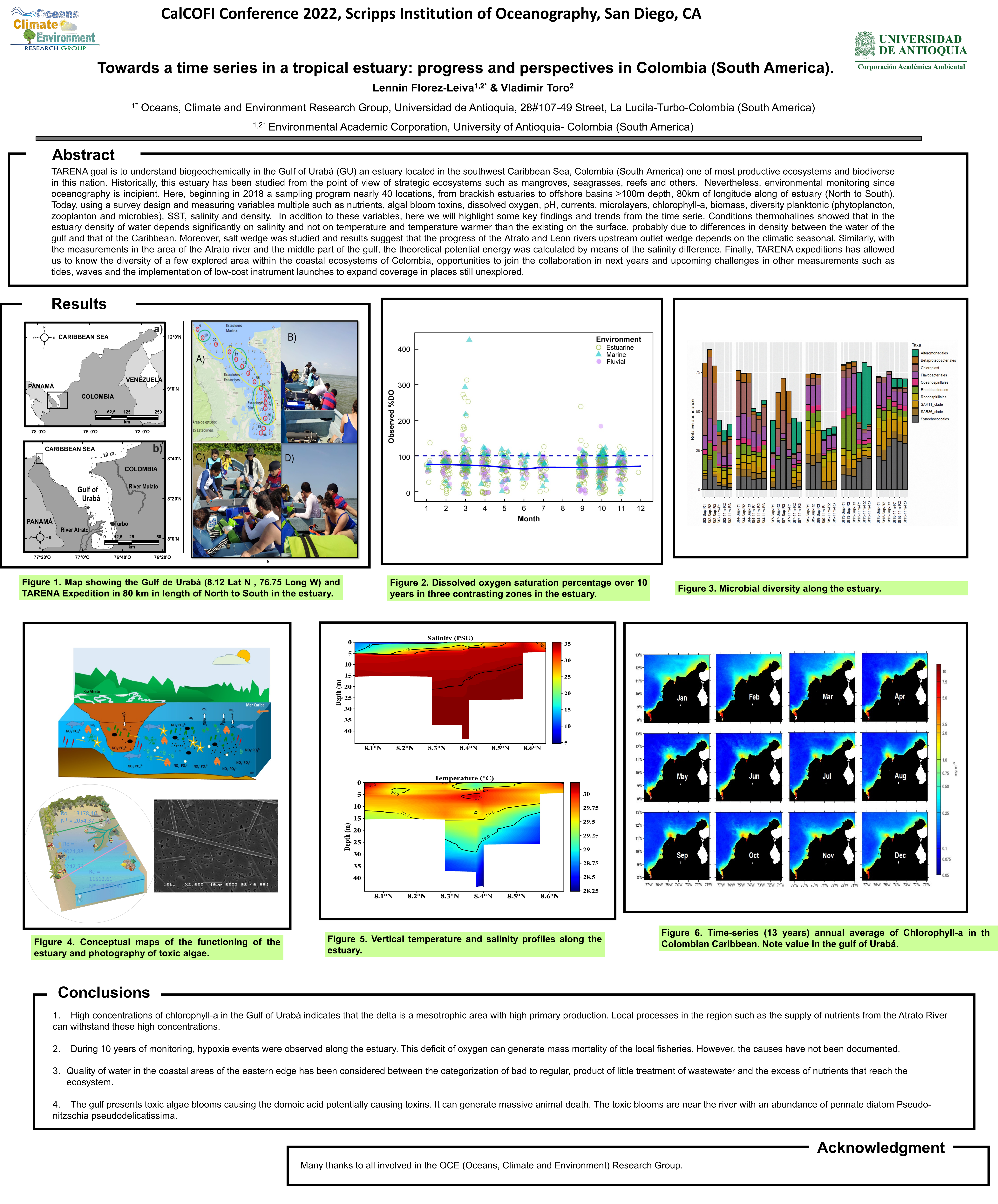
Lennin Florez-Leiva, Universidad de Antioquia, Colombia
Toro Vladimir, Environmental Academic Corporation, University of Antioquia, Turbo, COLOMBIA.
TARENA goal is to understand biogeochemically in the Gulf of Urabá (GU) an estuary located in the southwest Caribbean Sea, Colombia (South America) one of most productive ecosystems and biodiverse in this nation. Historically, this estuary has been studied from the point of view of strategic ecosystems such as mangroves, seagrasses, reefs and others. Nevertheless, environmental monitoring since oceanography is incipient. Here, beginning in 2018 a sampling program nearly 40 locations, from brackish estuaries to offshore basins >100m depth, 80km of longitude along of estuary (North to South). Today, using a survey design and measuring variables multiple such as nutrients, algal bloom toxins, dissolved oxygen, pH, currents, microlayers, chlorophyll-a, biomass, diversity planktonic (phytoplancton, zooplanton and microbies), SST, salinity and density. In addition to these variables, here we will highlight some key findings and trends from the time serie. Conditions thermohalines showed that in the estuary density of water depends significantly on salinity and not on temperature and temperature warmer than the existing on the surface, probably due to differences in density between the water of the gulf and that of the Caribbean. Moreover, salt wedge was studied and results suggest that the progress of the Atrato and Leon rivers upstream outlet wedge depends on the climatic seasonal. Similarly, with the measurements in the area of the Atrato river and the middle part of the gulf, the theoretical potential energy was calculated by means of the salinity difference. Finally, TARENA expeditions has allowed us to know the diversity of a few explored area within the coastal ecosystems of Colombia, opportunities to join the collaboration in next years and upcoming challenges in other measurements such as tides, waves and the implementation of low-cost instrument launches to expand coverage in places still unexplored.
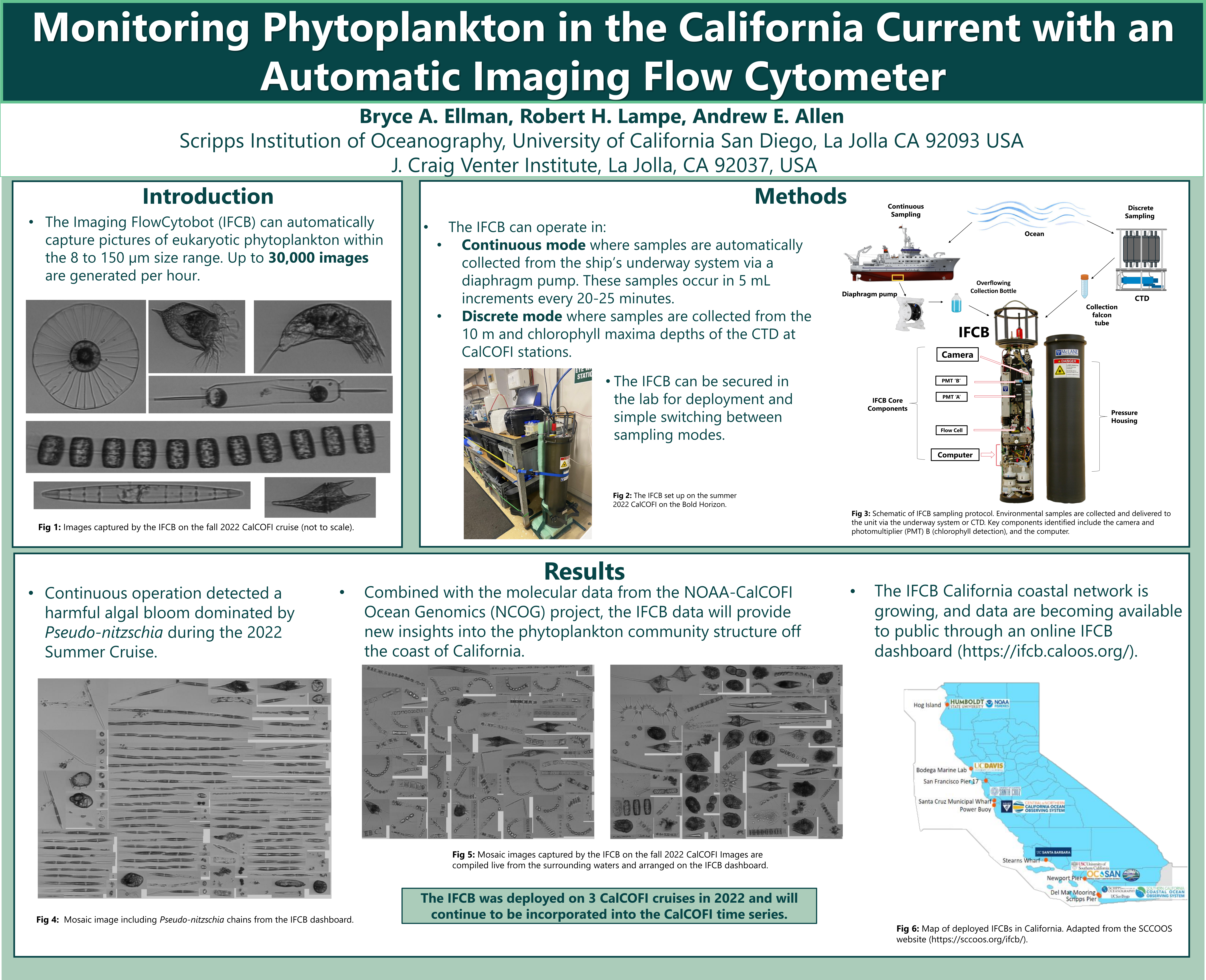
Bryce A. Ellman, J. Craig Venter Institute and Scripps Institution of Oceanography
Robert H. Lampe, J. Craig Venter Institute and Scripps Institution of Oceanography
Andrew E. Allen, J. Craig Venter Institute and Scripps Institution of Oceanography
The Imaging FlowCytobot (IFCB) is an instrument capable of automatically capturing pictures of the eukaryotic phytoplankton community (8 to 150 µm size range) providing near real-time data for environmental monitoring. First deployed on the summer 2022 CalCOFI cruise, the IFCB samples from the ship’s underway system to examine surface phytoplankton communities. Additional samples are being collected from the CTD providing more detailed data at 10 m and the chlorophyll maxima at CalCOFI stations. During the summer cruise, data informing the presence of a harmful algal bloom dominated by Pseudo-nitzschia were obtained supporting shore- and satellite-based monitoring efforts.The IFCB has now been deployed on three CalCOFI cruises, and it will continue to operate on all future cruises when possible. Phytoplankton imaging data from the IFCB combined with the molecular data from NOAA CalCOFI Ocean Genomics (NCOG) project will facilitate new insights into the phytoplankton community structure off the coast of California. Furthermore, these IFCB deployments are part of a growing network of IFCBs along the California Coast. Data from the network are being made publicly available through an online IFCB dashboard.
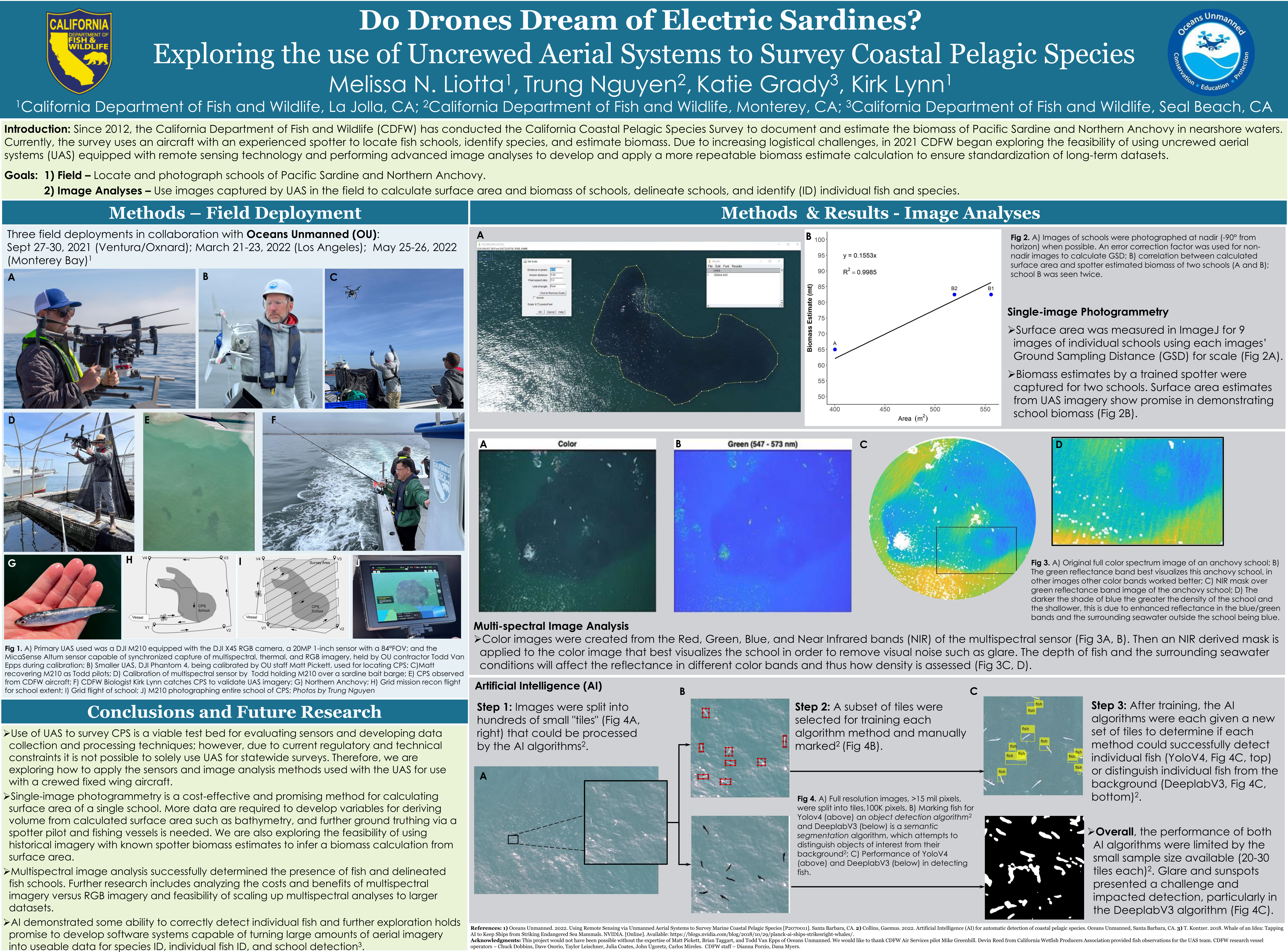
Melissa Liotta, California Department of Fish and Wildlife
Trung Nguyen California Department of Fish and Wildlife
Katie Grady, California Department of Fish and Wildlife
Kirk Lynn, California Department of Fish and Wildlife
Since 2012, the California Department of Fish and Wildlife (CDFW) has conducted the California Coastal Pelagic Species Survey to document and estimate the biomass of Pacific Sardine and Northern Anchovy in nearshore waters along the coast. This survey uses an aircraft with an experienced spotter to locate fish schools, identify species, and estimate biomass. Due to increasing logistical challenges, in 2021 CDFW began exploring the feasibility of using uncrewed aerial systems (UAS) equipped with remote sensing technology and advanced image analyses to develop and apply a more repeatable biomass estimate calculation to ensure standardization of long-term datasets. In collaboration with Oceans Unmanned, three field deployments occurred between September 2021 and May 2022, using two UAS equipped with a photogrammetric red-green-blue (RGB) camera or a multispectral sensor, including one deployment day with a piloted spotter plane for biomass estimates. Three techniques were utilized to estimate school surface area and differentiate species: single-image photogrammetry, multispectral image analysis, and artificial intelligence algorithms. While the multispectral UAS successfully photographed schools when located, the smaller RGB equipped UAS reconnaissance flights had difficulty locating schools due to their dynamic nature. Oceans Unmanned found that single-image photogrammetry had the greatest success in estimating school surface area with good correlation to the human spotter; however, as the spotter plane only observed and estimated biomass for two schools, more data are needed to show a robust correlation between spotter biomass estimates and school surface area. Multispectral imagery successfully identified species and delineated schools in a proof-of-concept scale analysis, and artificial intelligence algorithms were able to discern individual fish. Initial work has demonstrated the potential of UAS and advanced image analyses to survey coastal pelagic species, and future plans are currently in development to collect additional data and eventually scale up methods for use on piloted aircraft or larger UAS.
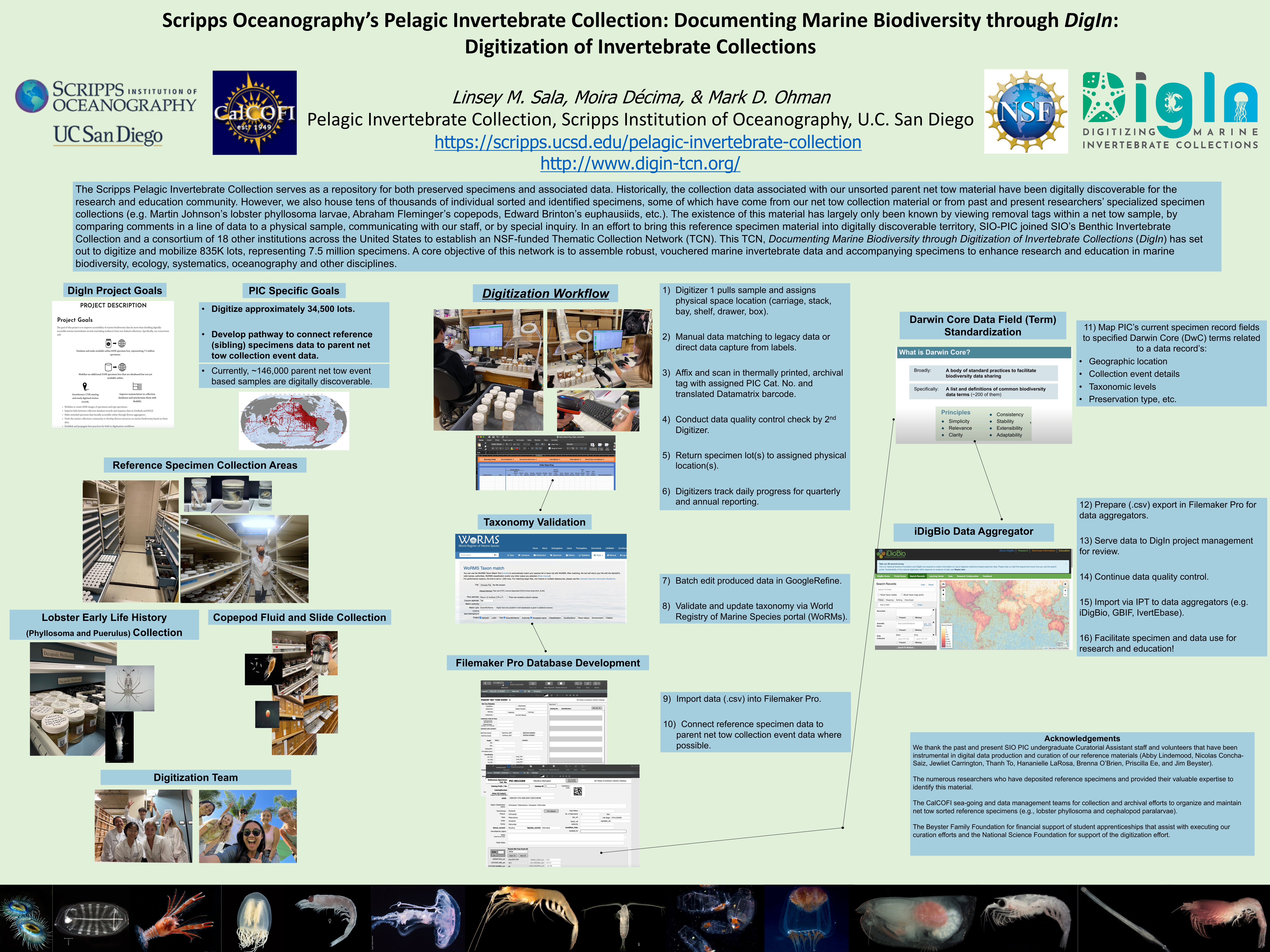
Lindey Sala, Pelagic Invertebrate Collection, Scripps Institution of Oceanography, U.C. San Diego
Mark Ohman, Pelagic Invertebrate Collection, Scripps Institution of Oceanography, U.C. San Diego
The Scripps Pelagic Invertebrate Collection serves as a repository for both preserved specimens and associated data. Historically, the collection data associated with our unsorted parent net tow material has been digitally discoverable for the research and education community. However, we also house tens of thousands of individual sorted and identified specimens, some of which have come from our net tow collection material or from past and present researchers’ specialized specimen collections (e.g. Martin Johnson’s lobster phyllosoma larvae, Abraham Fleminger’s copepods, Edward Brinton’s euphausiids, etc.). The existence of this material has largely only been known by viewing removal tags within a net tow sample, by comparing comments in a line of data to a physical sample, communicating with our staff, or by special inquiry. In an effort to bring this reference specimen material into digitally discoverable territory, SIO-PIC joined SIO’s Benthic Invertebrate Collection and a consortium of 18 other institutions across the United States to establish an NSF-funded Thematic Collection Network (TCN). This TCN, Documenting Marine Biodiversity through Digitization of Invertebrate Collections (DigIn) has set out to digitize and mobilize 835K lots, representing 7.5 million specimens (SIO-PIC plans to digitize ~34,500 lots). In the process, we are also introducing digital bar codes to sorted reference material and to samples in order to facilitate management of loans. Specimen data and metadata will be prepared according to Darwin Core Standards (DwC) and deposited into global data aggregators (e.g., iDigBio, GBIF), where they will then be publicly available. A core objective of this network is to assemble robust, vouchered marine invertebrate data and accompanying specimens to enhance research and education in marine biodiversity, ecology, systematics, oceanography and other disciplines.
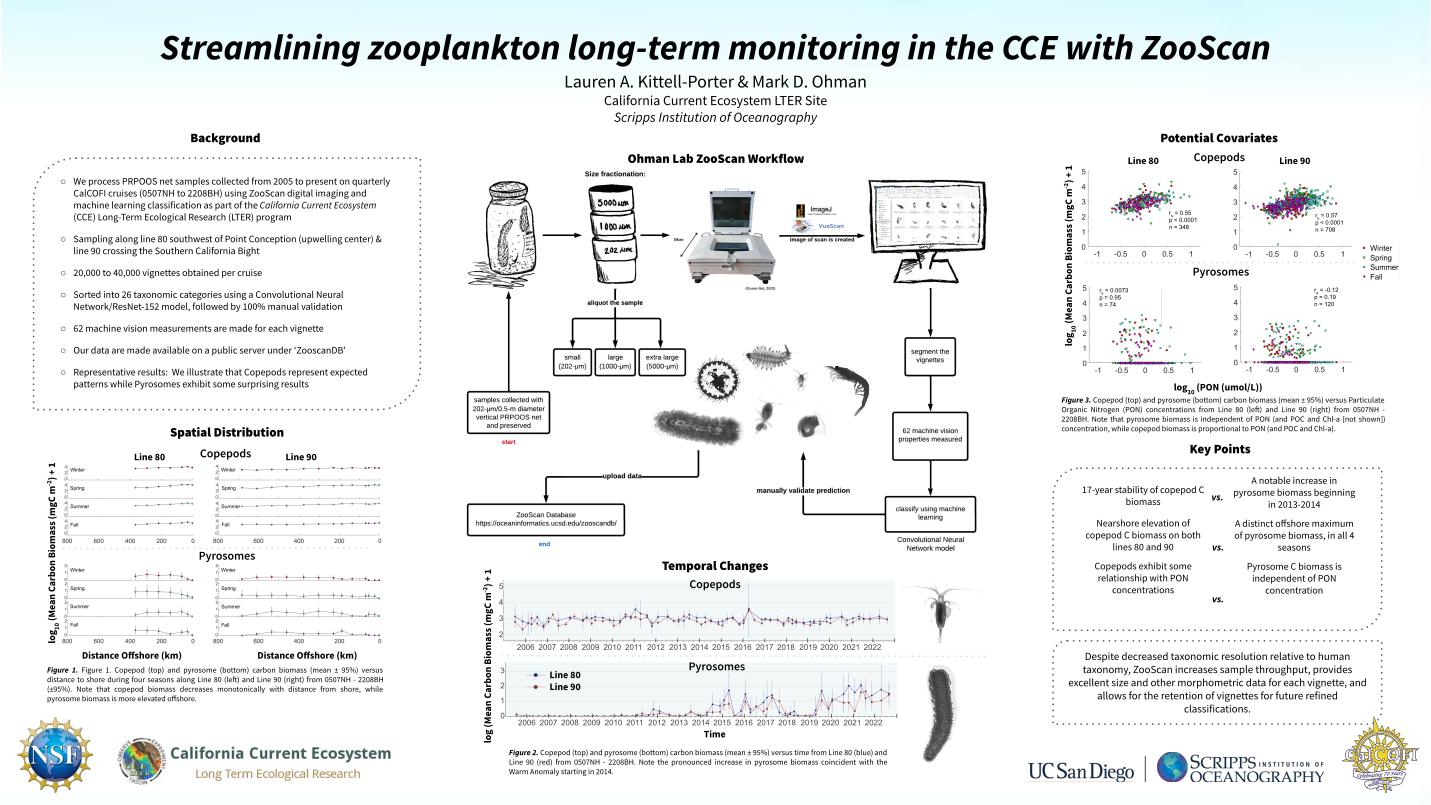
Lauren Kittell-Porter, Scripps Institution of Oceanography, U.C. San Diego
Mark Ohman, Pelagic Invertebrate Collection, Scripps Institution of Oceanography, U.C. San Diego
The ZooScan and associated software have been used to quantify zooplankton from 2005 to present from PRPOOS net samples collected on quarterly CalCOFI cruises as a part of the California Current Ecosystem (CCE) Long-Term Ecological Research (LTER) program. These samples are obtained along line 80 southwest of Point Conception, and line 90 crossing the Southern California Bight. When received onshore, each sample is separated into three size fractions: small (202 to 1,000 µm), large (1,000 to 5,000 µm), and extra-large (> 5000 µm). Aliquots of each size fraction are digitally scanned, then ImageJ-based routines are used to correct the background and segment each organism as a single vignette. A cruise produces roughly 20,000 to 40,000 vignettes which are classified into 26 taxonomic categories with a Convolutional Neural Network model with initial weights trained on a ResNet-152 model. All vignettes are manually validated for accuracy. More than 50 machine vision measurements are made on each vignette, facilitating excellent size class and other morphometric categorization within a taxon. Length-carbon relationships developed by the Ohman lab are used to express the data in C biomass as well as abundance. Our ZooScan data are posted promptly on a public server under ‘ZooscanDB’. We will illustrate some results generated from our analyses, including 17-year stability of copepod C biomass, but a notable increase in pyrosome biomass beginning in 2013-2014. Another pronounced difference between taxa is the nearshore elevation of copepod C biomass on both lines 80 and 90, but a distinct offshore maximum of pyrosome biomass, in all 4 seasons. Despite lessened taxonomic resolution relative to human taxonomy, ZooScan increases sample throughput, provides excellent size and other morphometric data for each vignette, and allows for the retention of vignettes for future refined classifications.
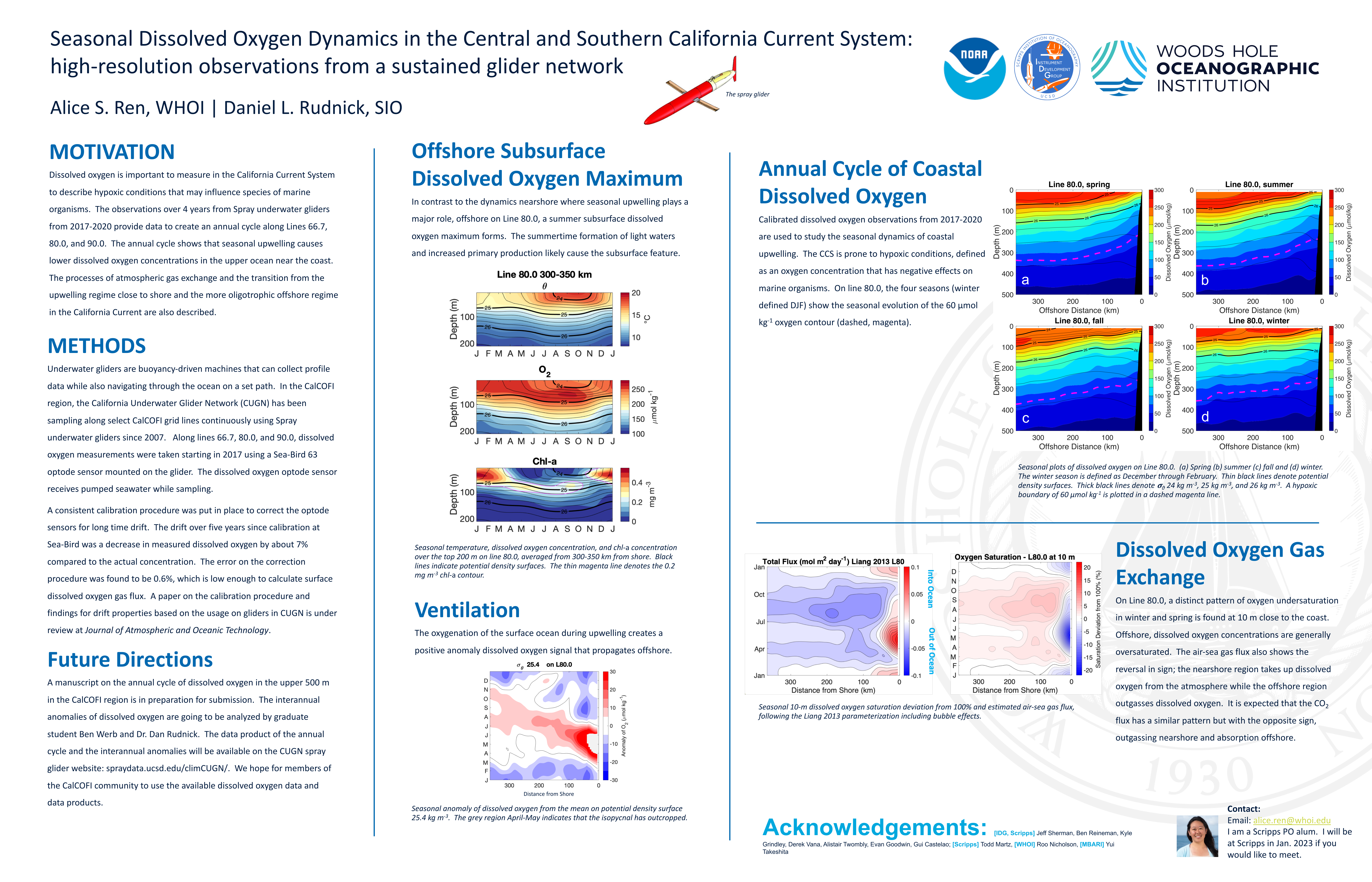
Alice Ren, Woods Hole Oceanographic Institution
Dan Rudnick, Scripps Institution of Oceanography
The distribution of dissolved oxygen in the California Current System on Lines 66.7, 80.0, and 90.0 is used to study the annual cycle of upwelling including atmospheric gas exchange and the annual shoaling of low-oxygen waters. Calibrated oxygen observations from the California Underwater Glider Network during 2017-2020 are used to create a high-resolution annual cycle of dissolved oxygen in the upper 500 m within 500 km of shore. During seasonal coastal upwelling, isopycnal heaving is the primary mechanism that deoxygenates the water column. Strong upwelling on Lines 66.7 and 80.0 causes a flux of oxygen from the atmosphere to the ocean in the vicinity of newly upwelled waters while further offshore supersaturated surface waters cause outgassing of oxygen. Outcropped coastal isopycnals deepen after upwelling and oxygenate the offshore ocean above 300 m. In the summer, a subsurface dissolved oxygen maximum forms on the offshore edge of the California Current System past the coastal transition zone. The magnitude and phenology of the annual cycle of dissolved oxygen may evolve in a changing climate.
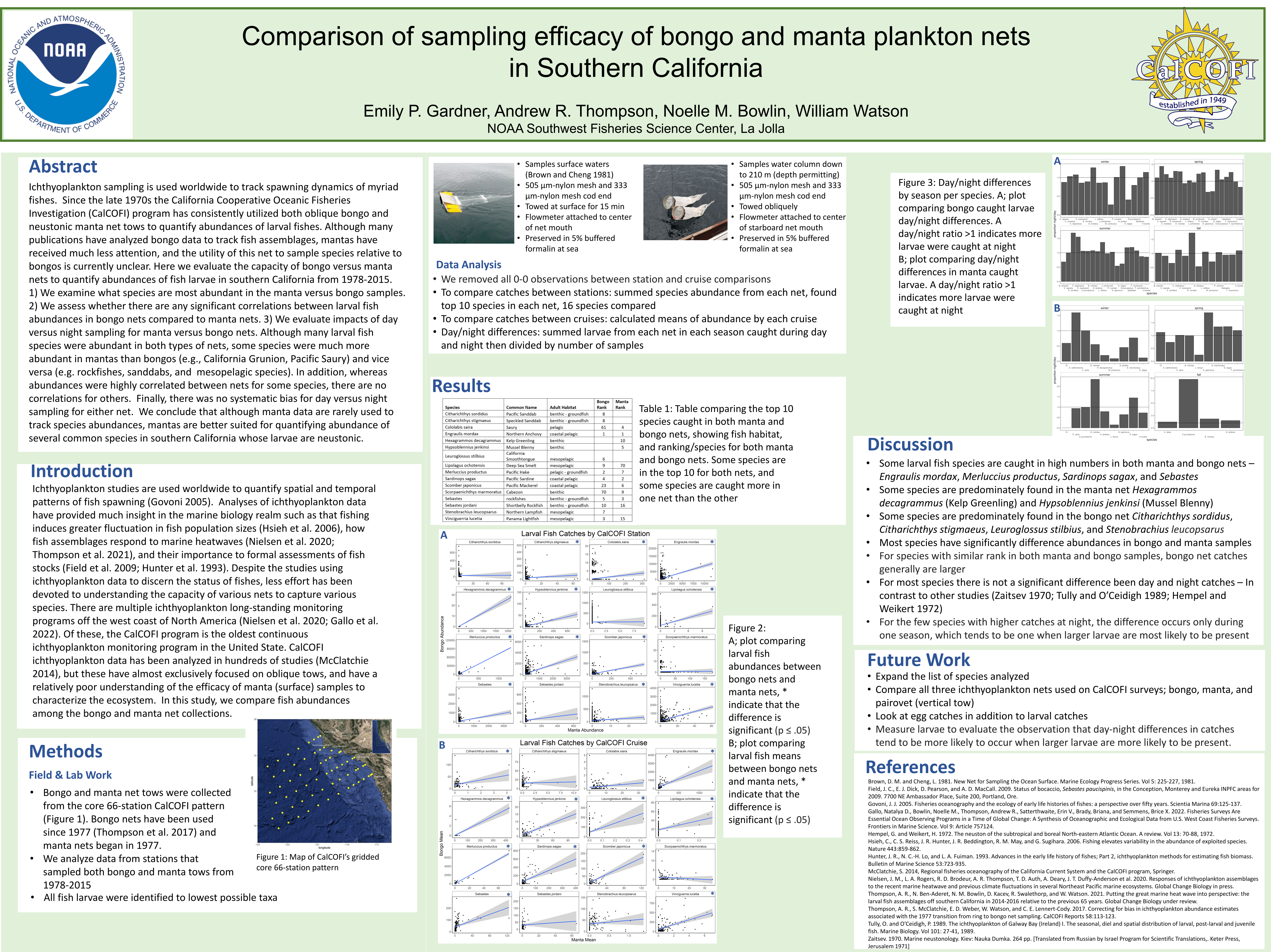
Emily Gardner, NMFS, NOAA Southwest Fisheries Science Center
Andrew R. Thompson, NMFS, NOAA Southwest Fisheries Science Center
Noelle M. Bowlin, NMFS, NOAA Southwest Fisheries Science Center
William Watson, NMFS, NOAA Southwest Fisheries Science Center
Ichthyoplankton sampling is used worldwide to track spawning dynamics of myriad fishes. Since the late 1970s the California Cooperative Oceanic Fisheries Investigation (CalCOFI) program has consistently utilized both oblique bongo and neustonic manta net tows to quantify abundances of larval fishes. Although many publications have analyzed bongo data to track fish assemblages, mantas have received much less attention, and the utility of this net to sample species relative to bongos is currently unclear. Here we evaluate the capacity of bongo versus manta nets to quantify abundances of fish larvae in southern California from 1978-2015. First, we examine what species are most abundant in the manta versus bongo samples. Second, we assess whether there are any significant correlations between larval fish abundances in bongo nets compared to manta nets. Third, we evaluate impacts of day versus night sampling for manta versus bongo nets. Although many larval fish species were abundant in both types of nets, some species were much more abundant in mantas than bongos (e.g., California Grunion, Pacific Saury) and vice versa (e.g. rockfishes, sanddabs, and mesopelagic species). In addition, whereas abundances were highly correlated between nets for some species, there are no correlations for others. Finally, there was no systematic bias for day versus night sampling for either net. We conclude that although manta data are rarely used to track species abundances, mantas are better suited for quantifying abundance of several common species in southern California whose larvae are neustonic.
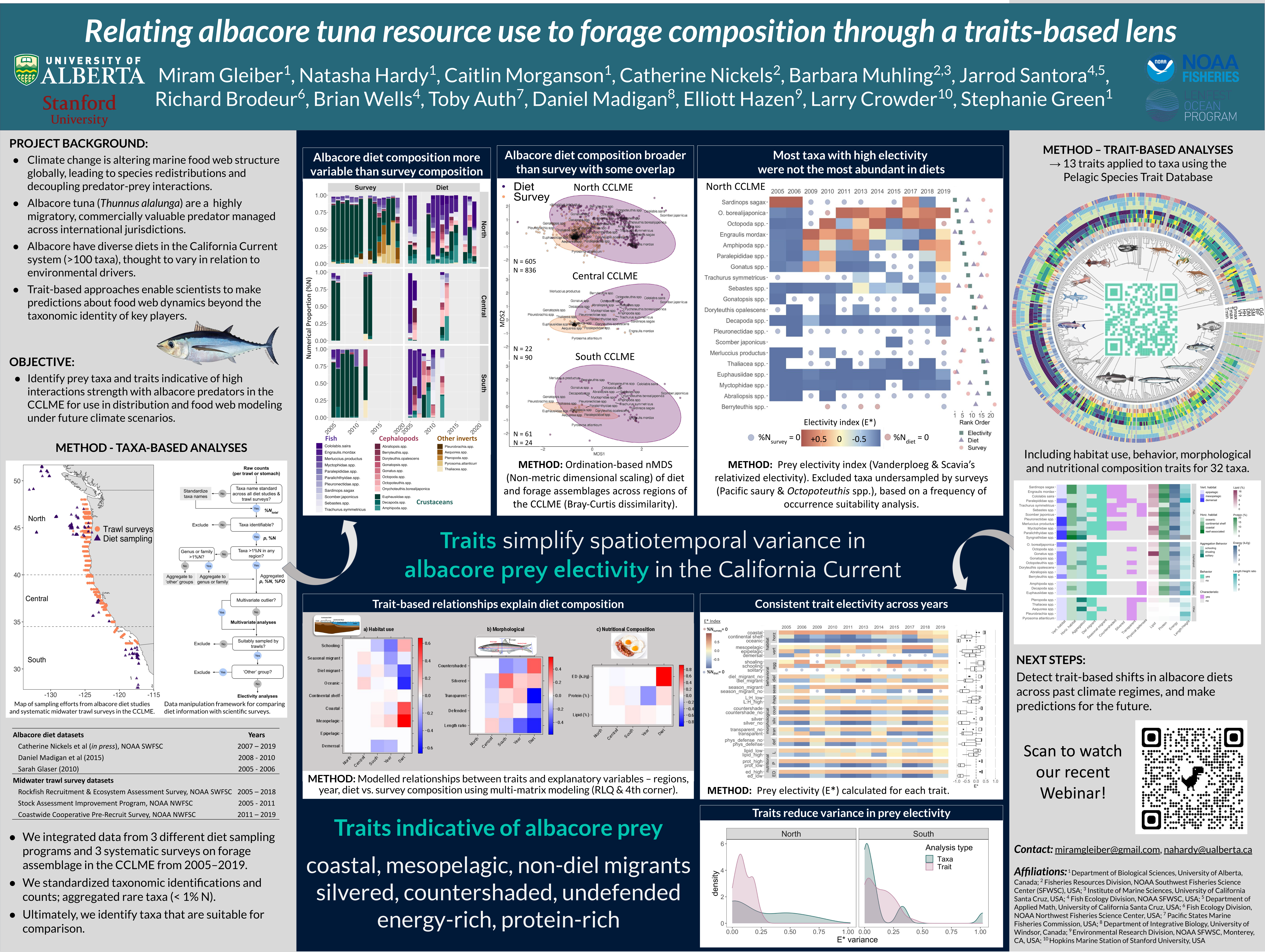
Miram R. Gleiber, Department of Biological Sciences, University of Alberta
Natasha A. Hardy, Department of Biological Sciences, University of Alberta
Caitlin J. Morganson, Department of Biological Sciences, University of Alberta,
Catherine F. Nickels, Fisheries Resources Division, NOAA Southwest Fisheries Science Center
Barbara A. Muhling, Fisheries Resources Division, NOAA Southwest Fisheries Science Center, Institute of Marine Sciences, U. C. Santa Cruz
Jarrod A. Santora, Fisheries Ecology Division, NOAA Southwest Fisheries Science Center, Department of Applied Math, U. C. Santa Cruz
Ric Brodeur, Fish Ecology Division, NOAA Northwest Fisheries Science Center
Brian Wells, Fisheries Ecology Division, NOAA Southwest Fisheries Science Center
Toby Auth, Pacific States Marine Fisheries Commission
Dan Madigan, Department of Integrative Biology, University of Windsor
Elliott L. Hazen, Environmental Research Division, NOAA Southwest Fisheries Science Center
Larry B. Crowder, Hopkins Marine Station of Stanford University
Stephanie J. Green, Department of Biological Sciences, University of Alberta
We currently face a knowledge gap in understanding biotic drivers of variance in resource use by highly migratory pelagic predators. Linking forage species composition to their consumption by predators can identify indicators of predator resource use in relation to ambient forage communities. This paper integrates long-term datasets on diet composition from stomach contents of a commercially valuable highly migratory predator, albacore tuna (Thunnus alalunga), and forage community composition from systematic pelagic midwater trawl surveys in the California Current Large Marine Ecosystem. These datasets represent two different resource samplers and enable us to quantify predator-prey interactions for albacore in relation to a diverse forage community across a time series from 2005-2019. We investigate both taxonomic and trait-based indicators of resource use and interaction strength linking albacore diet composition to surveyed forage communities. We found that trawl surveys sampled most albacore prey, based on relative prevalence and size class. While these datasets are generally appropriate for comparative analyses, we highlight key prey unsuitably sampled by trawls due to habitat overlap (saury, mesopelagic squids) or surveyed at larger sizes than consumed by albacore (saury, jack and pacific mackerel), representing a sampling gap in comparatively understanding albacore resource use. Multivariate analyses revealed overlap in resource use, and ultimately highlight taxonomic and trait-based differences in prey resources between albacore diets and surveyed communities, with regional and inter-annual variability. Prey electivity provided indicators of interaction strengths by measuring prey consumption relative to the surveyed abundances. Overall, analyses highlight consistent consumption of coastal and mesopelagic prey, schooling, undefended, silvered and countershaded taxa, with high protein and energy density traits despite regionally-distinct taxon-based prey resource use and selection patterns. Overall, we recommend using datasets that provide information on the availability of forage with these traits especially for further modeling of albacore resource use, diet shifts and population dynamics.
Josh Jones, Scripps Institution of Oceanography, U. C. San Diego
This exhibit will showcase marine mammal sounds.
Zachary Gold, NOAA, Pacific Marine Environmental Laboratory (PMEL)
This exhibit will showcase the passive eDNA Sampler.
7:00pm - 8:00pm - Poster Session II
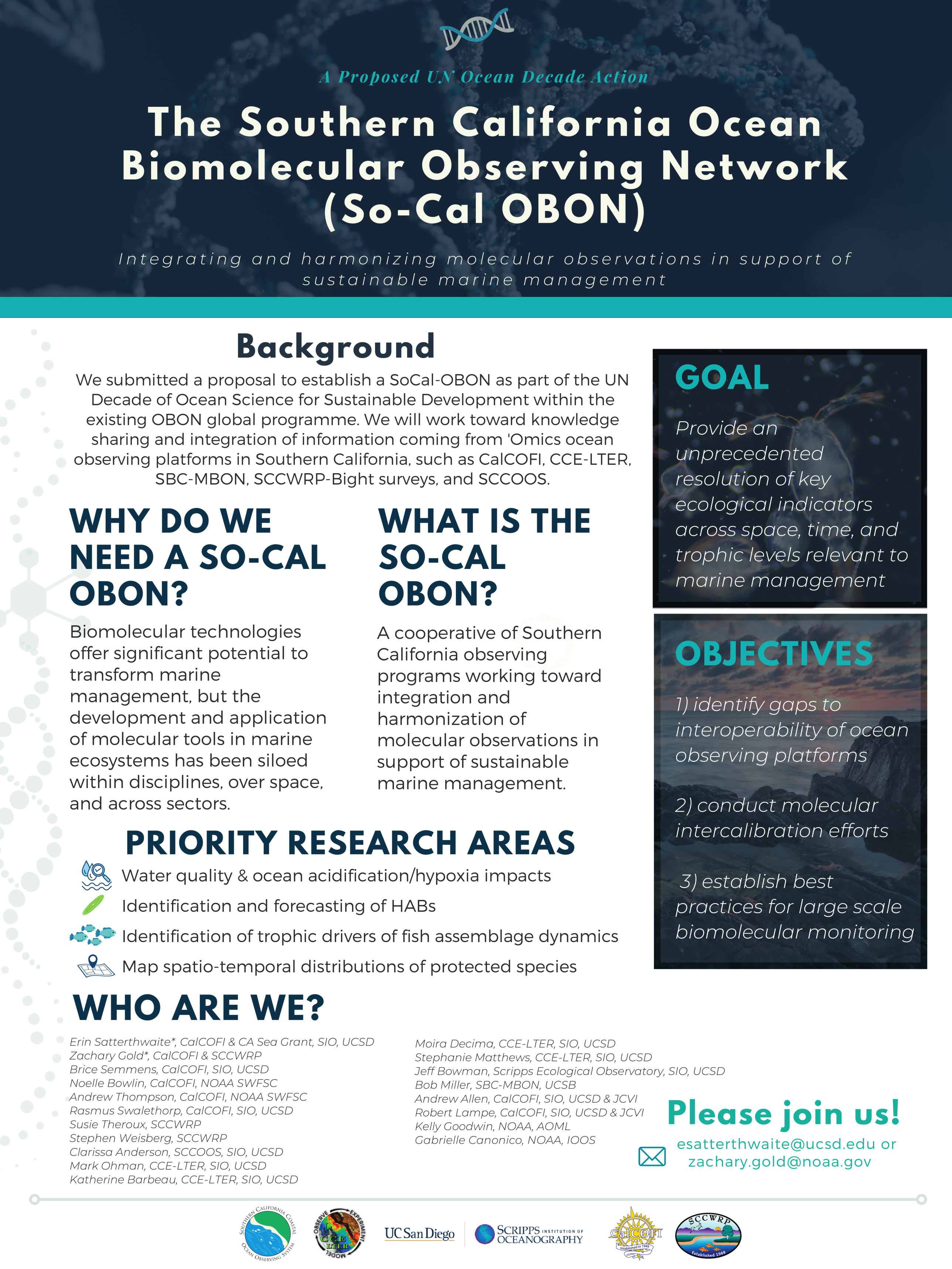
Co-authors (*co-presenters):
Erin Satterthwaite*, CalCOFI & CA Sea Grant, SIO, UCSD
Zachary Gold*, CalCOFI & SCCWRP
Brice Semmens, CalCOFI, SIO, UCSD
Noelle Bowlin, CalCOFI, NOAA SWFSC
Andrew Thompson, CalCOFI, NOAA SWFSC
Rasmus Swalethorp, CalCOFI, SIO, UCSD
Susie Theroux, SCCWRP
Stephen Weisberg, SCCWRP
Clarissa Anderson, SCCOOS, SIO, UCSD
Mark Ohman, CCE-LTER, SIO, UCSD
Katherine Barbeau, CCE-LTER, SIO, UCSD
Moira Decima, CCE-LTER, SIO, UCSD
Stephanie Matthews, CCE-LTER, SIO, UCSD
Jeff Bowman, Scripps Ecological Observatory, SIO, UCSD
Bob Miller, SBC-MBON, UCSB
Andrew Allen, CalCOFI, SIO, UCSD & JCVI
Robert Lampe, CalCOFI, SIO, UCSD & JCVI
Kelly Goodwin, NOAA, AOML
Gabrielle Canonico, NOAA, IOOS
Biomolecular technologies offer significant potential to improve and transform marine management, but the development and application of molecular tools in marine ecosystems has been siloed within disciplines (e.g., microbial ecology, phycology, fisheries), over space (e.g., nearshore versus offshore), and across sectors (regulatory, academic, industry). This has led to isolated advances and slow adoption of molecular tools for marine biomonitoring in support of sustainable marine management. To break down these barriers and advance the implementation of molecular tools for marine biomonitoring, we are proposing the creation of the Southern California Ocean Biomolecular Network (SoCal-OBON) within the context of the international process, the UN Decade of Ocean Science for Sustainable Development (2021- 2030).
The SoCal-OBON will be a cooperative of multiple southern California ocean observing programs and regional ocean stakeholders collectively promoting the integration and harmonization of molecular approaches in the Southern California regional biomonitoring efforts. The Cooperative’s main objective is to provide an unprecedented resolution of key ecological indicators across space, time, and biodiversity relevant to application, use, and management. The proposed Cooperative will: 1) identify gaps to interoperability of ocean observing platforms; 2) conduct molecular intercalibration efforts, and 3) establish best practices for large scale biomolecular monitoring. We hope that SoCal-OBON will serve to provide guidance on best practices and effectively integrate molecular observations off the coast of California and beyond.
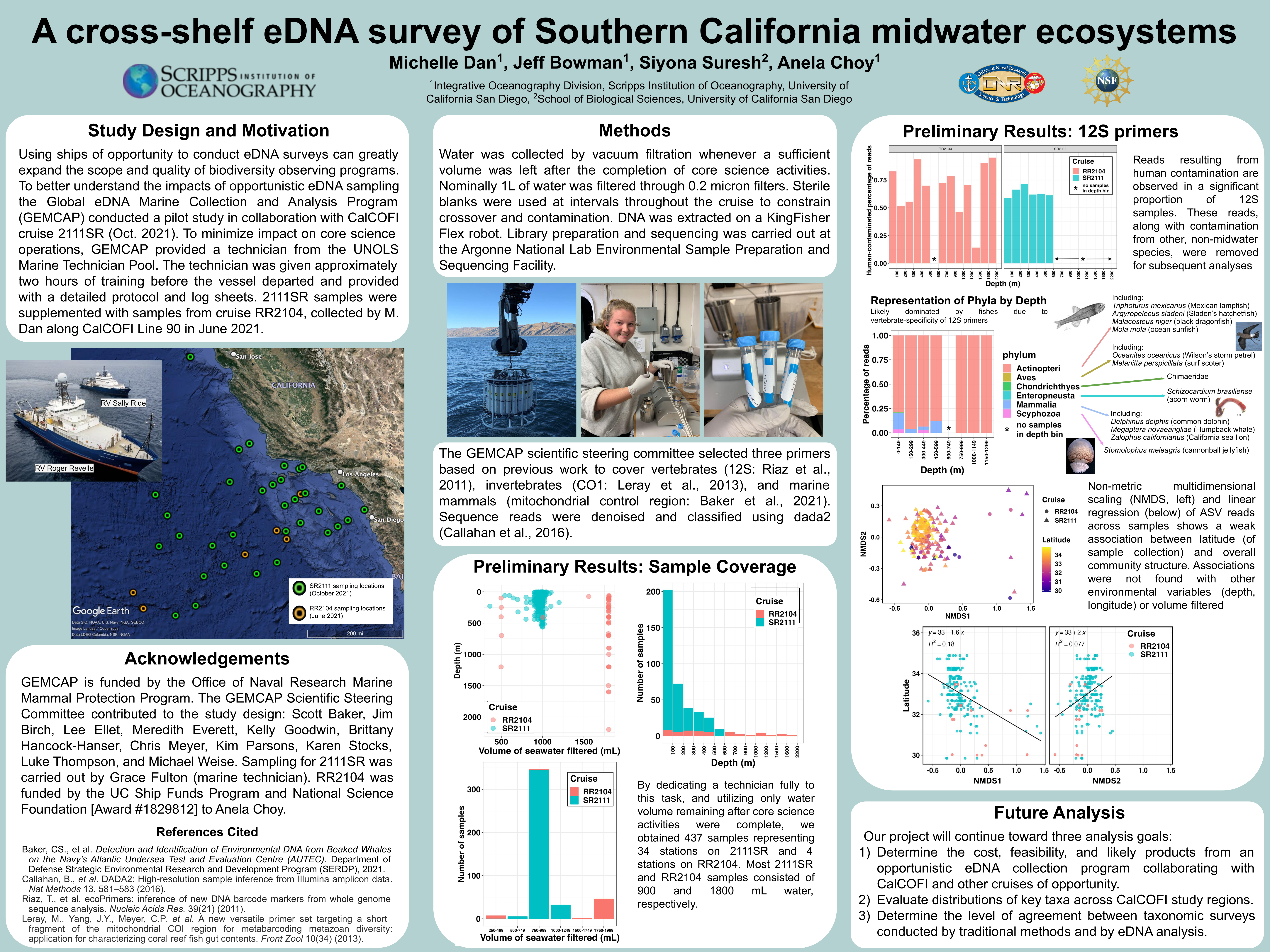
Michelle Dan, Scripps Institution of Oceanography, U. C. San Diego
Jeff Bowman, Scripps Institution of Oceanography, U. C. San Diego
Siyona Suresh, U. C. San Diego
Anela Choy, Scripps Institution of Oceanography, U. C. San Diego
The midwater represents more than 90% of Earth’s biosphere yet is critically undersampled and underdescribed due to limitations in technology and sampling logistics. It is crucial to better characterize the midwater, as its ecosystems play important roles in linking the surface ocean to deeper waters, exporting atmospheric carbon, and regulating nutrient cycles. Typical net-based midwater sampling methods (ie, MOCNESS; multiple opening/closing net and environmental sensing system) often destroy fragile taxa and exclude highly motile taxa. Moreover, MOCNESS methods are costly, requiring large teams to operate and extensive taxonomic expertise to identify net contents. To overcome biases of traditional net-based sampling methods, we have employed environmental DNA (eDNA) methods to assess midwater biodiversity. Seawater samples were opportunistically collected via CTD casts deployed from the surface to 2200 meter depths on two 2021 cruises along CalCOFI transects. eDNA was extracted from the seawater and sequenced using 12S, COI, and cetacean-specific primers in an effort to identify as many metazoan taxa as possible. Sequence reads were analyzed by phylogenetic placement using a custom-built bioinformatics pipeline and eukaryotic mitochondrial database. Here, we will present preliminary results comparing the results from eDNA and MOCNESS sampling methods. Further, we will identify gaps in genetic reference databases where additional midwater sequences are needed. This study establishes a protocol for midwater eDNA sample collection and a metazoan-focused bioinformatic pipeline, thus demonstrating potential of eDNA tools to survey midwater ecosystems.
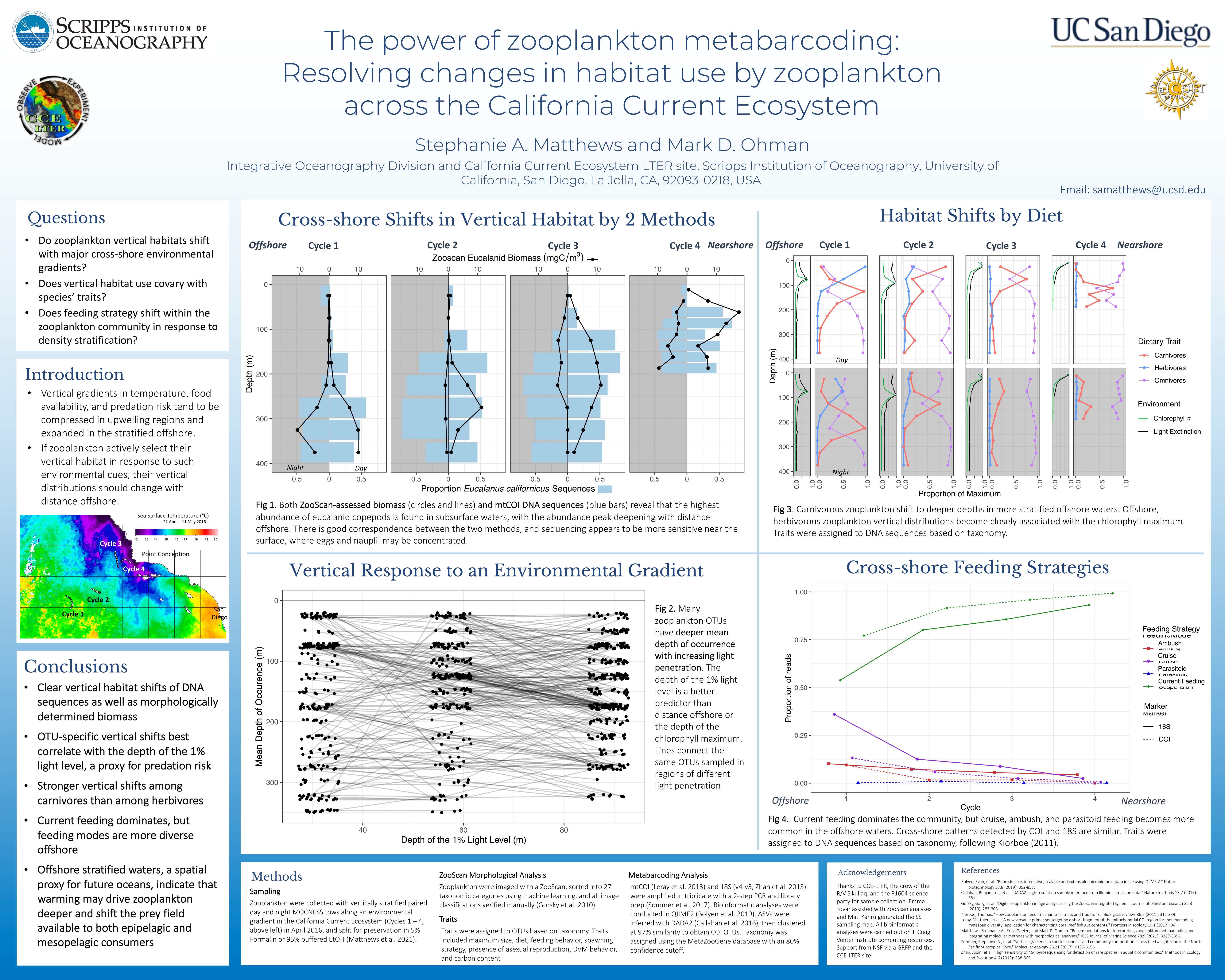
Stephanie Matthews, Integrative Oceanography Division and California Current Ecosystem LTER site, Scripps Institution of Oceanography, U. C. San Diego
Mark D. Ohman, Integrative Oceanography Division and California Current Ecosystem LTER site, Scripps Institution of Oceanography, U. C. San Diego
Metabarcoding of zooplankton from preserved plankton samples has the benefit of providing deep taxonomic resolution across the entire metazoan community, spanning multiple phyla with diverse morphological and life history traits. Here we illustrate the power of metabarcoding with a study focusing on cross-shore changes in zooplankton vertical habitat usage and population connectivity. The cross-shore gradient we address along CalCOFI line 80 in the <i>California Current Ecosystem</i> ranges from active upwelling, through more stratified mesotrophic environments, to the highly stratified offshore domain. These spatial differences can be used in a space-for-time substitution framework to test the potential effects of future warm, stratified oceans on species distributions and community composition. We hypothesized that mesozooplankton vertical distributions change in parallel with cross-shore environmental gradients, and that vertical shifts in habitat vary among taxa with different morphological, behavioral, and life history traits. We tested these hypotheses using DNA metabarcoding of depth stratified MOCNESS samples collected between the surface and 450m. We used mitochondrial and nuclear DNA markers (COI and 18S) to measure community composition across 1,282 Operational Taxonomic Units (OTUs) and 1,667 Amplicon Sequence Variants (ASVs). We found that vertical distributions of individual mesozooplankton taxa did shift in the cross-shore direction and that light penetration, a proxy for predation risk, was the strongest predictor of magnitude of vertical shifts. These shifts in vertical distribution were most uniform among carnivores, while herbivores tended to co-occur with the chlorophyll maximum even in clear offshore waters. We also observed greater cross-shore community similarity in the mesopelagic zone than in the surface ocean, indicating that deep-dwelling zooplankton communities may be structured by different pressures than surface communities. Our results indicate that increased stratification of future oceans will drive some epipelagic mesozooplankton deeper in the water column, shifting the prey field available to both epipelagic and mesopelagic consumers.
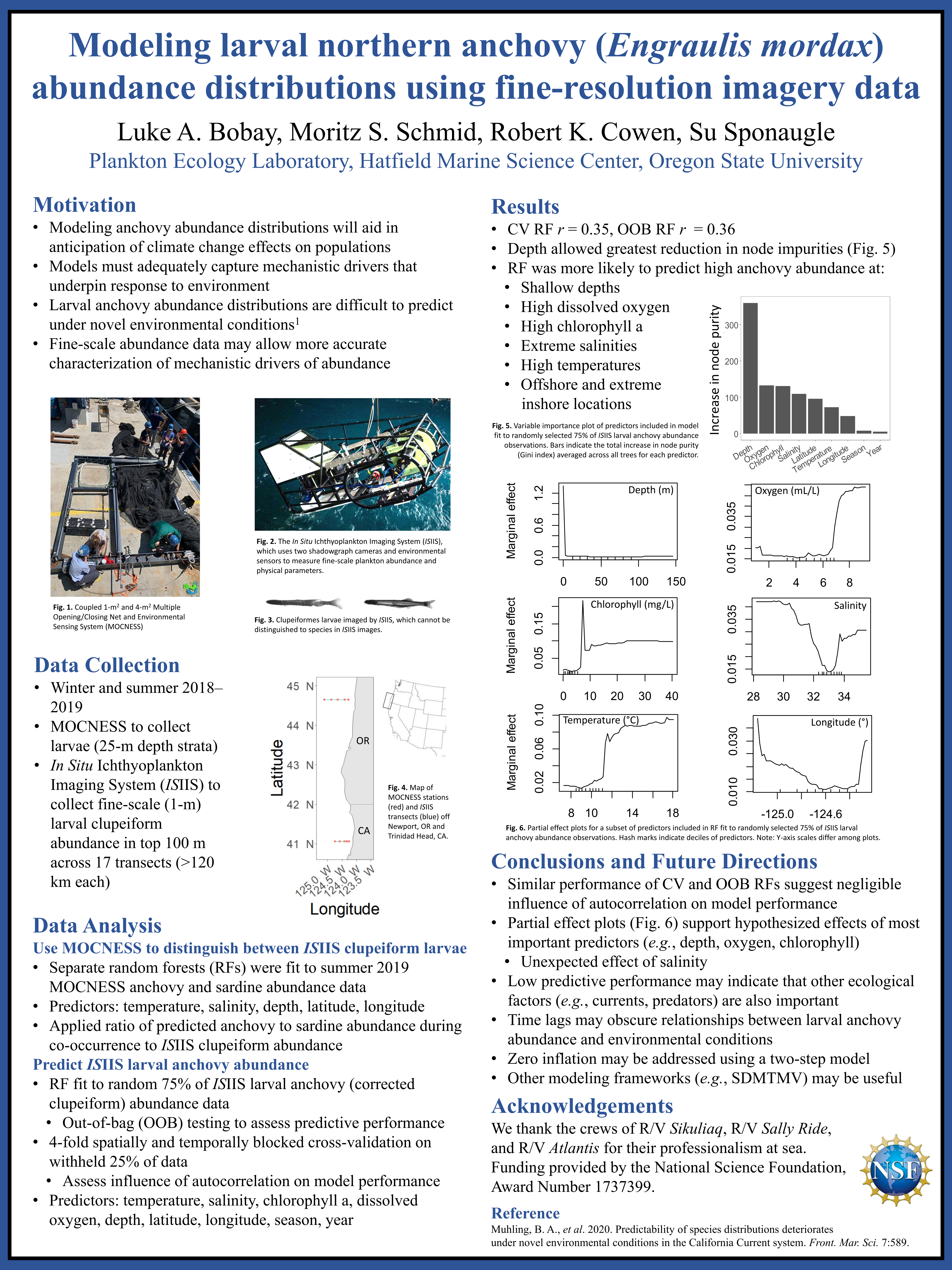
Luke A. Bobay, Oregon State University Plankton Ecology Laboratory
Moritz S. Schmid, Oregon State University Plankton Ecology Laboratory
Robert K. Cowen, Oregon State University Plankton Ecology Laboratory
Su Sponaugle, Oregon State University Plankton Ecology Laboratory
Changes in habitat availability caused by climate change are likely to influence the abundance of many marine species. During recent warm years, larval northern anchovy (Engraulis mordax) distributions in the northern California Current shifted north and shoreward. Accurately predicting larval northern anchovy abundance distributions using correlative relationships with environmental conditions could allow estimation of the overall abundance of larval northern anchovy under a changing climate, with implications for estimating recruitment to the adult population. However, recent work has demonstrated that larval northern anchovy distributions in the California Current are difficult to predict under novel environmental conditions. This may be because correlative species abundance distribution models (SADMs) must adequately capture mechanistic drivers that underpin species responses to the environment to accurately predict abundance distributions. Yet, traditional net sampling methods integrate larval fish catches over the length of a tow and may mask relationships between environmental conditions and larval fish abundance. Together with traditional net sampling, we collected fine-scale larval northern anchovy abundance data using the In Situ Ichthyoplankton Imaging System (ISIIS), which simultaneously records environmental conditions including temperature, dissolved oxygen, chlorophyll a, salinity, and depth. ISIIS was towed continuously along two cross-shelf transects (>120 km) off Trinidad Head, CA and Newport, OR during winter and summer 2018-2019. Plankton captured in the resulting images were automatically identified using a deep learning pipeline. The resulting larval northern anchovy abundance data were modeled using environmental conditions as predictors, and spatially blocked cross-validation was used to assess model performance. This exercise suggests that fine-scale plankton imagery data may be useful for characterizing relationships between larval fish abundance and environmental conditions to enhance the prediction of future larval fish abundances.
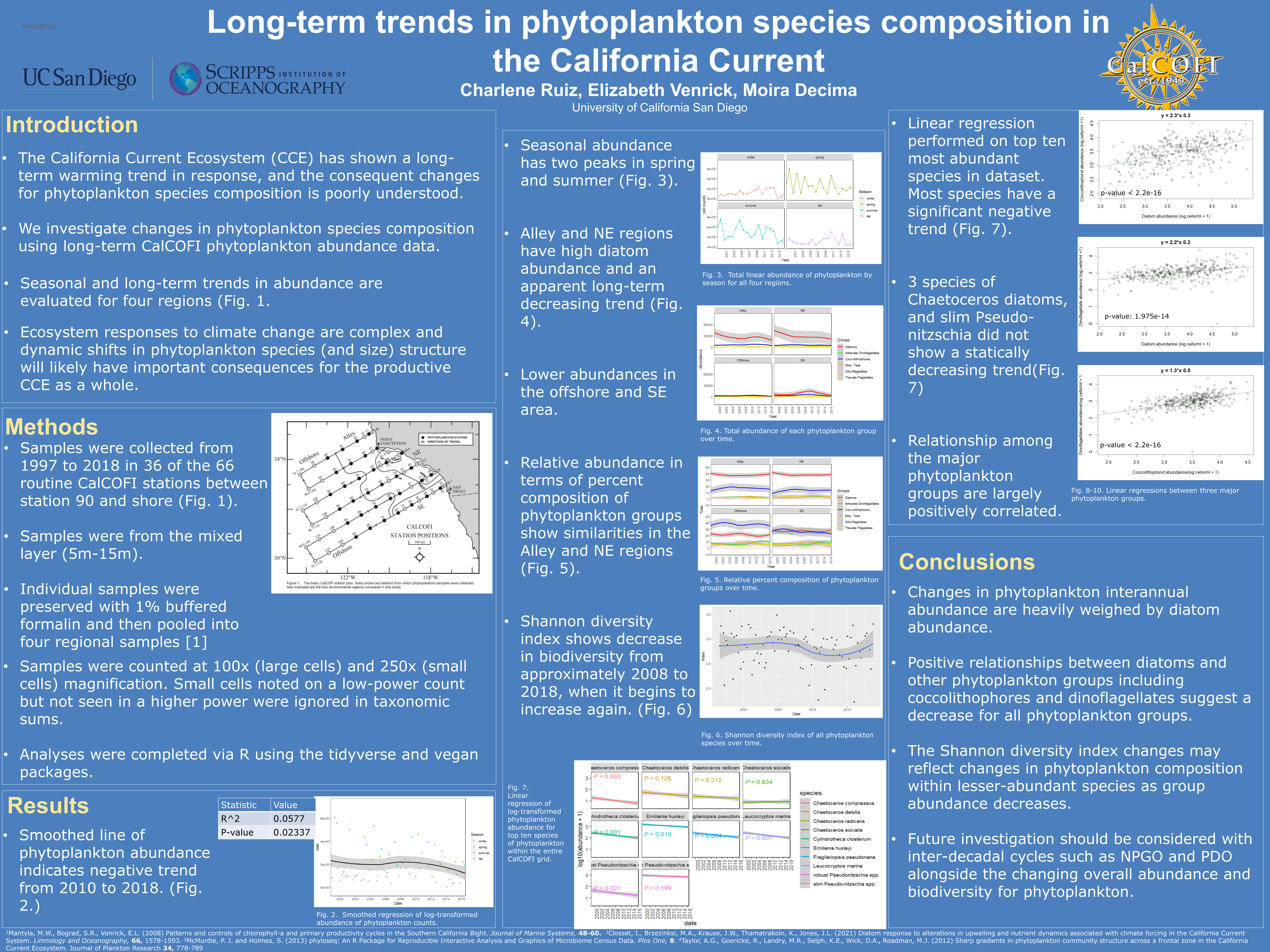
Charlene Ruiz, U. C. San Diego
Elizabeth Venrick, Scripps Institution of Oceanography, U. C. San Diego
Moira Decima, Scripps Institution of Oceanography, U. C. San Diego
Marine ecosystems are changing in response to accelerating warming and climate change. The California Current Ecosystem (CCE) has shown a long-term warming trend in response, and the consequent changes in primary production, phytoplankton species composition, and implications for food webs are poorly understood. In this study, we investigate changes in phytoplankton species composition within the CCE, using CalCOFI phytoplankton species composition data, from 1996 to 2018. Changes in abundance of the ten most important taxa are examined across the CalCOFI grid. The grid was divided into four regions (NE, SE, Alley, and Offshore), which have been shown to exhibit coherence in their phytoplankton community composition. We evaluate seasonal and long-term trends in phytoplankton abundance for these four regions, and investigated their relations to abiotic factors (e.g. temperature and nutrients) utilizing CalCOFI’s hydrographic bottle data. Ordination methods are used to determine the importance of environmental factors on the phytoplankton community. Ecosystem responses to climate change are complex and dynamic shifts in phytoplankton species (and size) structure will likely have important consequences for the productive CCE as a whole.
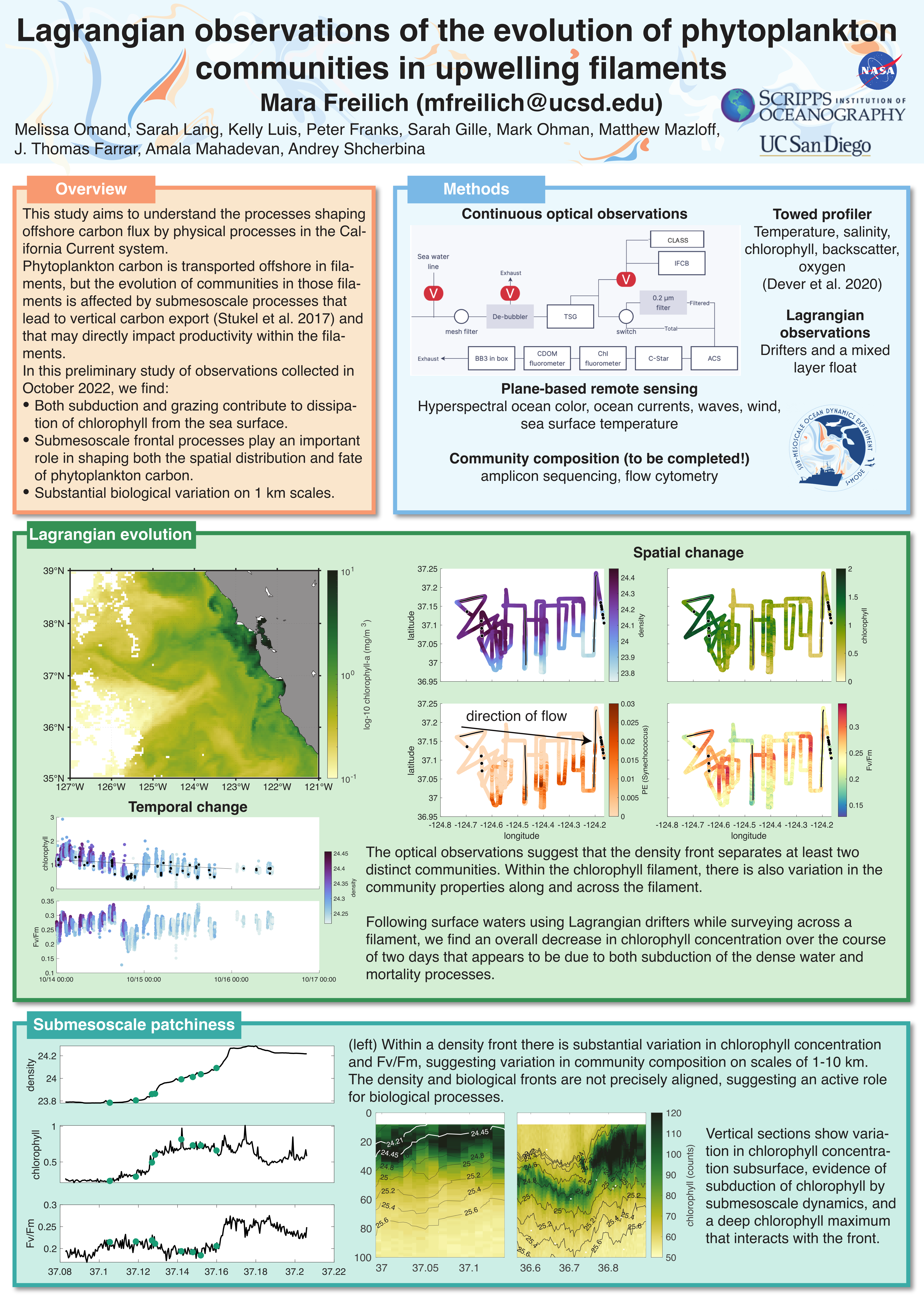
Mara Freilich, Scripps Institution of Oceanography, U. C. San Diego
Jeff Bowman, Scripps Institution of Oceanography, U. C. San Diego
Luc Lenain, Scripps Institution of Oceanography, U. C. San Diego
Sarah Gille, Scripps Institution of Oceanography, U. C. San Diego
As upwelling filaments move offshore, the phytoplankton communities in those filaments evolve over timescales of days to weeks as water moves offshore through mesoscale features. We study the time evolution of communities in an upwelling filament in the California Current system using a combination of in situ ship-based observations and remote sensing from the NASA S-MODE field campaign. We observe a transition to non-linear submesoscale dynamics, which are associated with vertical transport and enhanced mixing at scales of approximately 6 km. Within these submesoscale fronts, we find variation in the community structure of both phytoplankton and zooplankton. We use these observations to understand the interactions between mixing, lateral and vertical transport, and ecological processes and the implications of those interactions for offshore carbon transport in upwelling filaments in the California Current system.
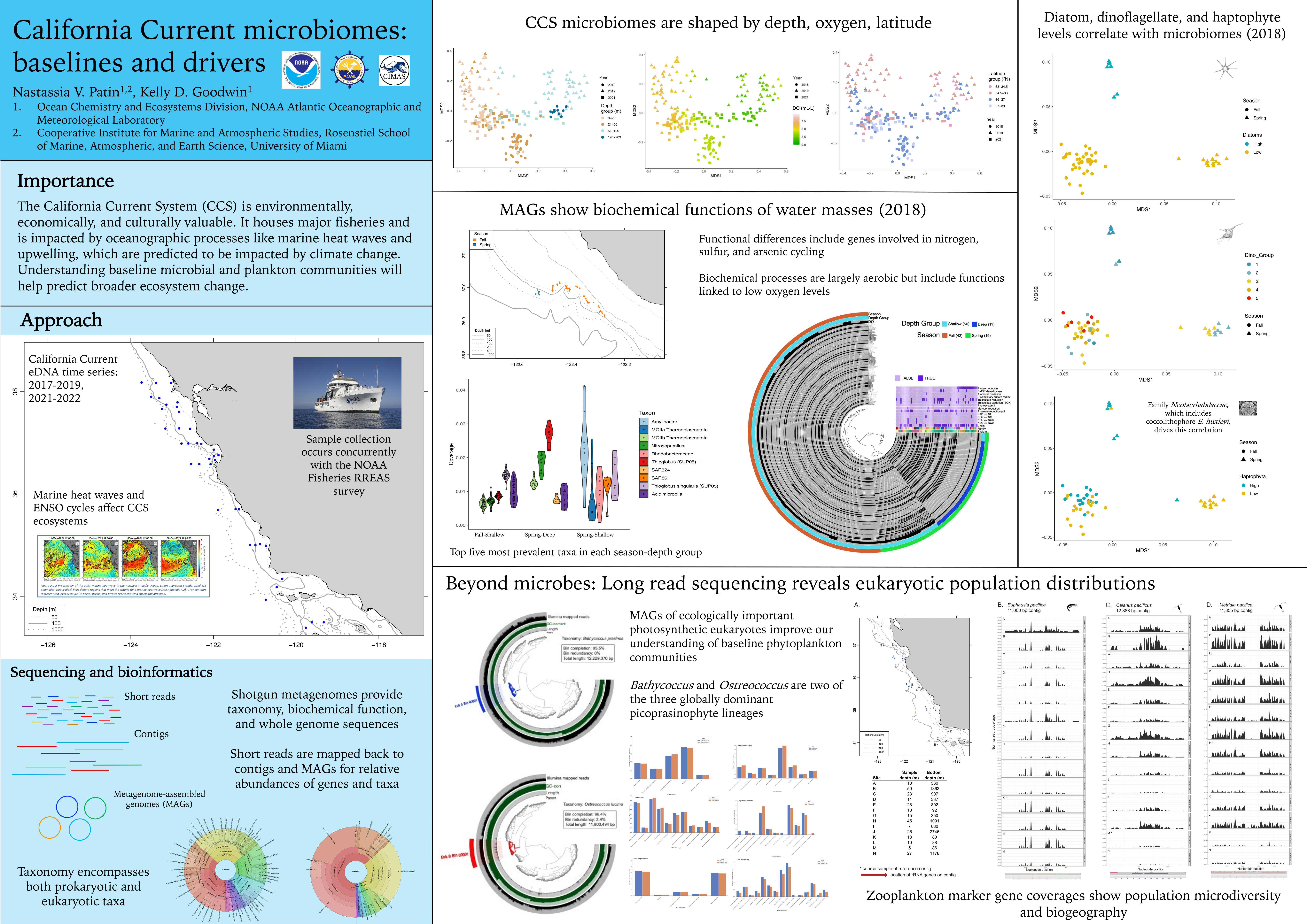
Nastassia Patin, NOAA, AOML
Kelly Goodwin, AOML
Kathleen Pitz, MBARI
Kobun Truelove, MBARI
Francisco Chavez, MBARI
The California Current is a highly productive ecosystem with several ecologically and economically valuable fisheries. Local oceanographic phenomena like upwelling and basin-scale environmental perturbations like El Niño/La Niña cycles can impact all levels of the food web; however, the propagation of these effects through trophic levels is largely unknown due to a poor understanding of linkages between microbes, plankton, and metazoans. Here, data from a multi-year time series of microbial metagenomes, metabarcoding, and ocean chemistry show how microbiomes correlate with phytoplankton and metazoan community dynamics. Metagenome-assembled genomes and gene functions were used to characterize microbial communities and connect them with higher trophic level community composition. Microbiome variability was driven largely by temperature and dissolved oxygen levels, but also showed distinct shifts among years. In addition, supervised machine learning methods were used to show how season- and depth-dependent microbiomes can predict phytoplankton regimes, particularly for diatoms and coccolithophores. This connectivity is driven by microdiverse heterotrophic microbial lineages including SAR324 and Nitrosopumilus. These combined ‘omics approaches provide a holistic overview of California Current water column ecosystems and may improve biological oceanographic modeling of environmental perturbations in the future.
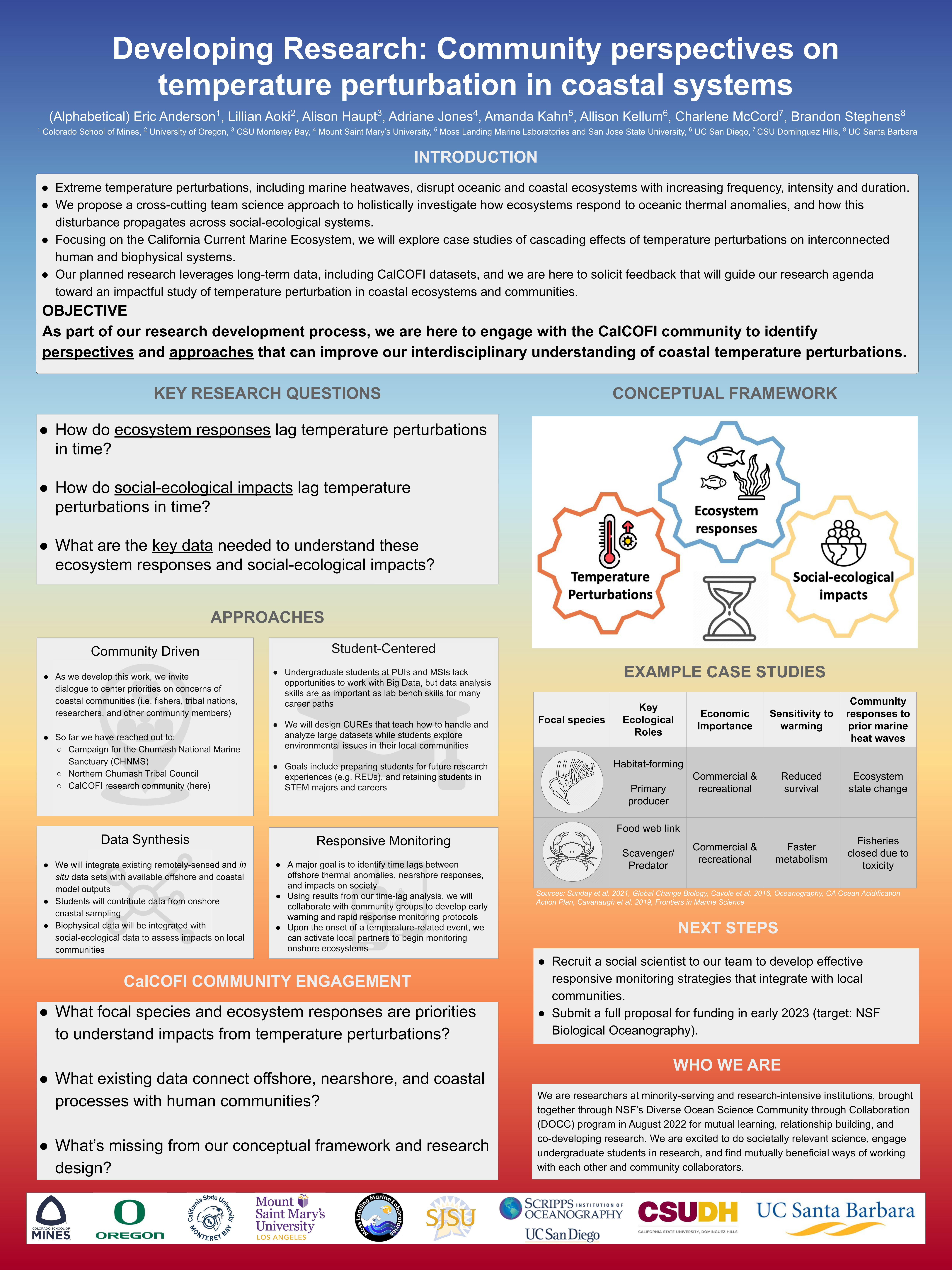
Lillian Aoki, University of Oregon
Eric Anderson, Colorado School of Mines
Extreme temperature perturbations, including marine heatwaves, disrupt oceanic and coastal ecosystems with increasing frequency, intensity and duration. Using a cross-cutting team science approach, we holistically investigate how ecosystem responses to oceanic temperature perturbations and thermal anomalies propagate across social-ecological systems. As part of our research development process, we are engaging with the CalCOFI community to identify perspectives and approaches that can improve our interdisciplinary understanding of coastal temperature perturbations. We invite a dialogue that centers the priorities and concerns of coastal communities, including fishers, tribal nations, and other community members including researchers. Focusing on the California Current Marine Ecosystem, we present exploratory case studies of the cascading effects of temperature perturbations on interconnected human and biophysical systems. Our planned research leverages long-term data, including CalCOFI datasets, and we are soliciting feedback to guide our research agenda toward an impactful study of temperature perturbation in coastal ecosystems and communities.
_p3.png)
Mark Ohman, Scripps Institution of Oceanography, U. C. San Diego
Moira Décima, Scripps Institution of Oceanography, U. C. San Diego Tristan Biard, Scripps Institution of Oceanography, U. C. San Diego
This exhibit will showcase in situ plankton imaging with a UVP (Underwater Vision Profiler)
Mateo Robbins, U. C. Santa Barbara
This exhibit will showcase AI image generation capabilities using MidJourney, an artificial intelligence program that creates images from textual descriptions.
December 7th, 2022
Workshops
8:00am - 12:00pm - Concurrent Workshops (<a title="Scripps Seaside Forum" <a="<a title="Scripps Seaside Forum"Scripps Seaside Forum - Conference Rooms)
8:30 am – 9:00 am: Introductions
9:00 am – 9:30 am: SoCal OBON Overview Talk (Zack)
9:30 am – 10:30 am: Discuss Priority Projects and Potential Funding Sources for SoCal-OBON
10:00am – 10:30 am: Break
10:30am – 11:30 am: Plan and coordinate leveraged studies to compare current sampling practices and identify key sources of platform specific sampling methodology disagreement.
11:30am – 12:00pm: Identify priority funding sources
Location:
Busselli/Loeb Room 160
Session Lead:
Zachary Gold, NOAA, Pacific Marine Environmental Laboratory (PMEL)
Session Co-leads:
Susanna Theroux, Southern California Coastal Watershed Research Project
Andrew Thompson, SWFSC, NOAA
Overview: The Southern California Ocean Biomolecular Observing Network’s (SoCal-OBON) objective is to provide an unprecedented resolution of key ecological indicators across space, time, and biodiversity relevant to marine management. To achieve this, the Network will integrate the suite of existing ocean observing platforms bridging nearshore and offshore biomonitoring efforts and apply standardized molecular approaches to best characterize biological communities and their response to environmental change across the Southern California Bight. This leveraged effort will combine physical and chemical measurements, advanced ocean imaging technologies, and molecular biomonitoring approaches to provide the ecological resolution needed to 1) understand the interplay of water quality and climate driven ocean acidification/hypoxia impacts on biological communities, 2) allow for the identification and forecasting of HABs, 3) better inform fisheries management through the identification of trophic and oceanographic drivers of assemblage dynamics, and 4) map spatio-temporal distributions of protected species. This is the third of a series of scoping meetings to identify priority objectives that will leverage regularly occurring conferences that have strong stakeholder buy-in and attendance. This workshop builds off of the 2nd National Marine eDNA Workshop and Bight ‘23 workshops to bring together key SoCal-OBON stakeholders to address the operational and scientific challenges of multi-platform interoperability.
Goals: Key to the success of harmonizing ocean monitoring across ocean observing platforms is the standardization of molecular sampling efforts. To achieve these objectives this workshops will convene representatives from each Network partner; local, state, and federal management agencies; industry representatives; and academics to 1) identify operational, methodological gaps between current monitoring efforts, 2) identify key management questions of concern and priority biodiversity targets to address them, 3) coordinate the design and validation of molecular assays for priority targets, and 4) plan and coordinate leveraged studies to compare current sampling practices and identify key sources of platform specific sampling methodology disagreement. Ultimately, the direct comparisons of molecular methodologies spawned from this meeting will provide the baseline intercalibration data needed to identify current operational gaps between observing platforms and help inform best practices needed for successful integration of molecular biomonitoring efforts. The results and outcomes of our integration efforts will directly inform the national NOAA Strategic Molecular Strategy and CA Ocean Protection Council Ocean Monitoring Plan, serving as a template for strategic integration of molecular ocean observing worldwide. Preliminary results from intercalibration exercises will allow for the integration of data streams, providing unprecedented resolution of marine biodiversity across the Southern California Bight. These results will provide critical insights into the offshore and nearshore linkages in this system and serve as a springboard for the development and advancement of molecular ocean observations to address pressing ocean challenges like ocean acidification and hypoxia impacts, prediction and forecasting of HABs, higher resolution fisheries assessments, and high resolution mapping of protected species.
8:30 am – 9:00 am: Introductions
9:00 am – 10:00 am: Presentations – Workshop & Policy context
- Matt Savoca (Stanford) – Workshop Overview (15 minutes)
- Scott Coffin (CA Water Board) – Legislative drivers for microplastics, PFAS, ubiquitous tire chemical (6PPD Quinone) (15 min, pre-recorded)
- Amalia Almada (USC) & Lian Guo (California Sea Grant) – DDT+ Research Needs Assessment report (15 minutes)
- Noelle Bowlin (NOAA SWFSC) – CalCOFI Pollutant Sampling Efforts
- Karen McLaughlin (SCCWRP) – SCCWRP Pollutant Sampling Efforts
Location:
Charles Scripps Room 150
Session Lead:
Matthew Savoca, Stanford University
Session Co-lead:
Matthew Savoca, Stanford
Erin Satterthwaite, CalCOFI
Karen McLaughlin, SCCWRP
Amalia Almada, USC Sea Grant
Overview: The environment is contaminated by hundreds of thousands of legacy, emerging, and novel synthetic compounds that are persistent in the environment on scales of decades to centuries. Long-term datasets are essential to uncover patterns over time as synthetic chemicals are introduced, regulated, and phased out of production. At the same time there are numerous compounds of unknown origin, use, effects, and fates that have permeated marine systems. Long term monitoring datasets, such as CalCOFI, SCCWRP Bight Monitoring Program, and SWAMP, provide unparalleled temporal resolution of planktonic organisms in the Southern California Bight to delve into questions related to the chronology of contaminants in this ecosystem. The purpose of this roundtable is to explore current efforts to understand pollutant monitoring in CA (e.g., DDT+, PFAS, microplastics), understand what samples exist for contaminant analyses, understand opportunities for longer term/consistent sample collection, and how to develop a collaborative, statewide sampling paradigm moving forward that leverages existing pollutant monitoring efforts and incorporates pollutants into existing time series programs. We will also allot time to discuss possible mechanisms to fund this work, exploring the potential for a future proposal.
Goals: Explore the legislative drivers for pollutant monitoring related to the case studies below in CA Review what pollutant studies and more long-term efforts have been conducted from existing pollutant monitoring/observing systems in CA Discuss what capabilities exist within our networks & existing programs to provide and process samples for which pollutants Consider pollutant studies that could be conducted using archived CalCOFI samples Propose sample collection framework for future CalCOFI cruises to use for pollutant studies Brainstorm ways to fund this work which includes analysis as well as coordination of living database/platform of available samples and/or interested community of practice
8:30 am – 9:00 am: Introductions
9:00 am – 9:15 am: Gains in recruitment forecasting methods (Eric Ward)
9:15 am – 9:45 am: Discussion
- How to deal with large numbers of possible environmental drivers?
- Stationary vs. non-stationary relationships
- Integrating multiple/disparate data sources
- Are there species/life histories where this might be most promising?
- What other kinds of data are we missing? (length – weight info from CalCOFI, etc)
10:00 am – 10:30 am: Discussion
- State/jurisdiction lines in assessments? (e.g. split assessments for certain species)
- How do we step forward in time (predict recruitment vs. assess pops): yearly? more frequent / less formal updates for more stocks?
- Benchmarks?
- How to link non-parametric prediction methods with likelihood assessment frameworks?
11:00 am – 11:15 am: Challenges and opportunities in integrating recruitment predictions into Fisheries Management Council decision making (Kristin Marshall)
11:15am – 11:45 am: Discussion Catch advice (e.g. HCRs, risk policy) Ecosystem Advice (e.g., Ecosystem Status Reports, risk assessments)
11:45 am – 12:00 pm Wrap up, next steps
Location:
Edward W. ‘Ted’ Scripps II Room 165
Session Lead:
Brice Semmens, CalCOFI, SIO
Session Co-lead:
Eric Ward, NWFSC, NMFS, NOAA
Overview: Understanding the environmental drivers of fish recruitment has been a major area of research for more than a century. In an era of non-stationary ocean conditions, quantifying these relationships is essential for robust management of fish populations. At the same time, new modes of observation, combined with robust long-term monitoring programs, continue to generate increasingly complex fisheries and ecosystem data streams. Recently, a number of studies have demonstrated that fish recruitment can be forecasted over short periods of time using covariates related to larval densities, data from similar species, and/or raw or derived environmental time-series. A variety of emerging computational methods have also been used to improve forecasts and assess their skill, including linear, non-linear and non-parametric approaches. While the forecasting skill of these methods can be surprisingly high, the path towards using these forecasts within traditional fisheries stock assessments remains unclear. Challenges include dealing with large numbers of possible environmental drivers, non-stationary relationships, complex estimation models that already integrate many data sources, incorporating non-parametric methods into stock assessment’s likelihood-based framework, and the sometimes weak relationships between single drivers and recruitment. This workshop aims to bring together experts in forecasting and fisheries/resource assessment to discuss gains in recruitment forecasting methods, and approaches for integrating such forecasts into common fisheries assessment methods and associated management tools.
Goals: Discuss emerging recruitment prediction tools, and brainstorm methods for incorporating prediction into fisheries management workflows, including but not limited assessment methods.
10:00am - 10:30am - Morning Coffee/Tea Break
12:00pm - Conference ends
Conference Details
Virtual Participants
Virtual meeting information will be sent via email closer to the conference date
Location and Map
Events will be held at the <a title="southwest fisheries science center" <a="<a title="southwest fisheries science center"Southwest Fisheries Science Center & <a title="Martine Johnson House" <a="<a title="Martin Johnson House"Martin Johnson House at Scripps Institution of Oceanography
For a campus map please see: <a title="https://scripps.ucsd.edu/about/maps " <a="<a title=" scripps="" seaside="" forum-="" foyer"https://scripps.ucsd.edu/about/maps
Parking and Transportation Information
Parking is limited at Southwest Fisheries Science Center building (SWFSC) so we recommend utilizing the hotel shuttles, parking near your hotel, or finding parking on La Jolla Shores Drive (~15 minute walk) or at the La Jolla Shores Beach parking lot (~30 minute walk). From these locations you can walk, rideshare, or rent a bike/scooter to campus.
Attire
Since some of the conference will be outdoors, please bring very warm clothes for evening events as the ocean breeze can get chilly, especially in the winter months.
COVID
Illnesses and COVID-19 are a reality of our ‘new normal’, so please follow the guidelines below:
- Please complete the
<a title="Self Symptom Screening " <a="<a title=" scripps="" seaside="" forum-="" foyer"Self Symptom Screening
& the <a title="Visitor Symptom Screening Checklist " <a="<a title=" scripps="" seaside="" forum-="" foyer"Visitor Symptom Screening Checklist
prior to arrival.
- Although facial coverings are not required, masks are welcome and remain an important preventive measure against COVID-19 and other infectious diseases.
- Please do not travel to the conference if you are experiencing COVID-19 symptoms, you've tested positive for COVID-19 within the last 10 days, or you meet public health criteria for quarantine.
To Register
1) Fill out this <a title="brief registration form" brief registration form (~5 minutes to complete) to indicate your interest in the CalCOFI conference this year and to share input by Nov. 1st
2) Pay the registration fees for the conference through <a title="EventBrite" EventBrite by Nov. 1st
3) Optional-- Submit your talks through the <a title="abstract submission form" abstract submission form by Nov. 1st